Secrets Of The Secret Six: DC’s ‘Mission: Impossible’
The Maze Agency: Detective Fiction In Comic Form (with Adam Hughes)
All-American Girl; Marvel Comics’ First Super-Heroine!
It’s A Jungle Out There: The Story of Lorna the Jungle Girl (sometimes Queen)
Red Circle Sorcery: Archie’s Best-Kept Secret
Reina M. Bull – Mystery 1950s SF Illustrator
The ‘WandaMySister’ Years: Best. Avengers. Ever!
Strange Times 2: When Adam Delved
Sandra & Magi: The Only Excuse For Lucy Lane
Strange Times: The Doctor Is In
Sally Forth! Remembering the UK’s ‘comic for the adventurous girl’
The Persons From U.N.C.L.E.
Looking for Love in all the wrong places – the strange story of Fishboy, Denizen of the Deep
Fantastic Fours
The Short but Brilliant Life of the Inferior Five
What’s In A Name? Why We’re Called ’30th Century Comics’
Secrets Of The Secret Six: DC’s ‘Mission: Impossible’
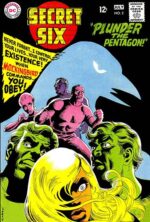 (with grateful acknowledgment to Keith W. Williams, whose similarly-titled article in the 1970’s informed much of my thinking on the topic.)
(with grateful acknowledgment to Keith W. Williams, whose similarly-titled article in the 1970’s informed much of my thinking on the topic.)
The TV show, Mission: Impossible, debuted in 1966, each episode opening with the team’s field leader selecting a task force from multiple dossiers to combat the Menace of the Week. In theory, this could have resulted in a cast of dozens; in reality, contractual obligations ‘selected’ the same series regulars plus maybe one guest-star, but nevertheless the series was a huge hit, running to 1973 for more than 150 episodes.
What’s this got to do with comics? Well, in 1968, DC was changing. Responding to the challenge posed by the rise of Marvel Comics, they were trying for new audiences, and a lot of experimental titles were being launched.
One such was Secret Six, a 1968 launch featuring a team of specialists recruited to perform covert missions, taking down targets beyond the reach of the law.
Writer E. Nelson Bridwell had clearly been briefed to rip-off Mission: Impossible as closely as possible, but, similarly to his earlier work on the Inferior Five, he took that remit and tweaked it into something quite distinctive.
In this case, the six protagonists were, as per M:I, specialists with distinctive skill sets, but each also, possessed a secret weakness in their past which, if disclosed or exploited would cause imprisonment, disgrace, or death. The ‘secret’ in the series’ title referred therefore not only to the furtive nature of their missions, but to the shadowed pasts of our various heroes.
And the biggest secret of all was that the group’s mysterious handler, code-named Mockingbird, his or her appearance and voice disguised in their pre-recorded briefings, was one of the team;
King Savage, stuntman and Korean War veteran, broke under torture and betrayed his country; Mockingbird arranged his escape so that he became a decorated hero – but the truth would reveal him as a traitor.
Carlo Di Rienzi, escapologist and magician, whose wife was killed and his son crippled in a revenge attack by organized crime; with Mockingbird’s treatments, the boy will walk again – as long as Carlo plays ball.
Lili Du Neuve, actress and disguise expert, falsely accused of murder and headed for the guillotine, until an equally mendacious alibi got her acquitted. But the alibi can be recanted at any time.
Tiger Force, former heavyweight champion on the run from the Mob after refusing to throw a fight, given a new name and life by Mockingbird;
Dr. August Durant, noted physicist, infected by enemy agents with a lethal virus for which only Mockingbird has the cure – one pill, day by day, to ensure ‘Doc’s’ compliance.
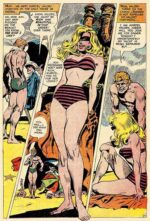 And Crimson Dawn, model, whose unusual upbringing gave her prowess in martial arts and marksmanship, but whose naiveté led her into an abusive marriage. Mockingbird reinvented her into a glamorous icon – whose sordid past could be revealed at any time.
And Crimson Dawn, model, whose unusual upbringing gave her prowess in martial arts and marksmanship, but whose naiveté led her into an abusive marriage. Mockingbird reinvented her into a glamorous icon – whose sordid past could be revealed at any time.
Each issue Mockingbird assigned the team to incriminate, incarcerate, or sometimes dispose of, enemies of the free world, international operations (unusually for the time, fully half our heroes were non-American) with meticulously-constructed plots, relying on no contrivances or ‘cheats’, and grounded firmly in the bounds of reality; no superhumans or supernatural elements in the Six’s world.
This verisimilitude was aided by artists Frank Springer (# 1-2) and Jack Sparling (#3-7), whose naturalistic style added conviction to the series. In the case of Sparling in particular – a notoriously inconsistent artist, whose on-page presentation varied widely from one assignment to another – his work on the Six was some of his best.
I mentioned earlier that credibility was a keynote of the series, but there was one overriding narrative coincidence; after the first couple of establishing issues, fate conspired to link the Six’s cases with events in their own histories. Over the course of the series, Lili revealed the true perpetrator of the crime she had been accused of, Carlo avenged the murder of his wife, and Crimson took healthy revenge upon her former husband, among other events. Had the series continued a few more issues, Mockingbird’s hold on the various members might have become so diluted as to be meaningless – although doubtless ENB would have come up with more reasons why the Six continued to operate.
 As it happened, though, he was denied the opportunity. Secret Six was cancelled with #7, one year after launch, and the group seemed destined to become a footnote in comic history, with the identity of Mockingbird still unrevealed.
As it happened, though, he was denied the opportunity. Secret Six was cancelled with #7, one year after launch, and the group seemed destined to become a footnote in comic history, with the identity of Mockingbird still unrevealed.
Until 1988 and DC’s ill-advised and short lived attempt to relaunch Action Comics as a weekly anthology title, with a number of short serialized strips. Most of these were pretty dismal, but one stood out as a quality successor. In Action Comics Weekly #601, writer Martin Pasko brought us a new Secret Six series.
Unlike most comics characters, who live in an eternal ageless ‘now’, the Six had aged in real time. Twenty years after their last recorded adventure, the youngest was now in her forties, and the elder teammates pensioners, broken down by age and infirmity. After two decades of inactivity, they were summoned once more by Mockingbird to train their successors – but en route, their plane crashes, with fatal results.
The new Secret Six, therefore, have to go into the field untrained. Mitch Hoberman, special effects tech crippled by arthritis; Ladonna Jameal, actress disfigured and rendered mute by an acid attack; Tony Mantegna, journalist deafened in an explosion; Luke McKendrick, paraplegic former track star; Vic Sommers, ex-marine blinded by shrapnel; and Dr. Maria Verdugo, computer scientist with incurable epilepsy.
All have variations on the same motivation. Having become disabled, their natural abilities are restored by cybernetic devices, enabling them to resume their former lives – and to do Mockingbird’s bidding.
Because one of the original Six survives. And Mockingbird can remotely disable his (or her) ‘gifts’ at any time, if the Six fail to comply.
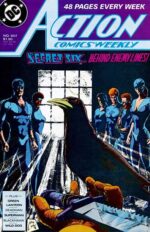 In two 12-chapter serials (Action Comics Weekly #601-612, and #619-630), Pasko did an exemplary job of evoking the original series and updating it, tying in missions to a larger story arc, and eventually resolving the question of who was Mockingbird, in a way that was entirely appropriate and satisfying to readers of the original.
In two 12-chapter serials (Action Comics Weekly #601-612, and #619-630), Pasko did an exemplary job of evoking the original series and updating it, tying in missions to a larger story arc, and eventually resolving the question of who was Mockingbird, in a way that was entirely appropriate and satisfying to readers of the original.
In this, he was aided by two veteran artists; the criminally underestimated Dan Spiegle illustrated the first serial, and in a pleasing nostalgic touch, the second was drawn by Frank Springer, the very first Secret Six artist. Each skillfully retained the authentic grounding of the series, with only one fantastic element – the cybernetic/bionic devices supplied by Mockingbird, borderline science-fiction in their sophistication – not detracting from the strip’s matter of fact tone.
The strip concluded with the possibility of a new Mockingbird, and a further sequel; but having been largely lost in the morass of inferior material ACW – often described as Action Comics Weakly because of its shoddy content – the strip caused no ‘ripples’, and, the title having been shoplifted for Gail Simone’s unrelated super-villain team-up title, the Secret Six remains unacknowledged by the DC Universe at large.
 Well, except for the far-better-than-it-ought-to-be Scooby-Doo Team-Up; in issue #30 (of the print version; #59 & #60 of the online version, don’t ask) the original line-up of the Secret Six made an appearance, together with Cave Carson’s crew, Rip Hunter’s team, the Challengers of the Unknown and the Sea Devils. It’s not canonical – but it is charming as hell, and, again, the secret of Mockingbird is disclosed!
Well, except for the far-better-than-it-ought-to-be Scooby-Doo Team-Up; in issue #30 (of the print version; #59 & #60 of the online version, don’t ask) the original line-up of the Secret Six made an appearance, together with Cave Carson’s crew, Rip Hunter’s team, the Challengers of the Unknown and the Sea Devils. It’s not canonical – but it is charming as hell, and, again, the secret of Mockingbird is disclosed!
Fear not; there will be no spoilers here. You want the identity of Mockingbird, you won’t get it from me. Google it. Or better yet, buy the comics – there aren’t that many to hunt down, and they well reward reading.
Will Morgan, May 2020
Back to Top
The Maze Agency: Detective Fiction In Comic Form (with Adam Hughes)
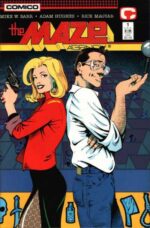 Something a little different this week, as we take a look at something more modern than our usual fare (if you count 1988 as modern, that is!). The Maze Agency was one of the series to benefit from the ‘Indie Boom’ of the 1980s, a rich vein of quality material from other than the big publishers and not focusing on super-heroes. It’s crime or detective fiction, of the Golden Age whodunit style of Christie, Doyle, Sayers etc rather than the hard-boiled stuff of Chandler and Spillane etc, but with a contemporary setting.
Something a little different this week, as we take a look at something more modern than our usual fare (if you count 1988 as modern, that is!). The Maze Agency was one of the series to benefit from the ‘Indie Boom’ of the 1980s, a rich vein of quality material from other than the big publishers and not focusing on super-heroes. It’s crime or detective fiction, of the Golden Age whodunit style of Christie, Doyle, Sayers etc rather than the hard-boiled stuff of Chandler and Spillane etc, but with a contemporary setting.
The Maze Agency is a New York detective outfit run by Jennifer Mays, ex-CIA, wealthy, successful and drop dead gorgeous. She’s joined on her cases by her chap Gabriel Webb, a true crime writer and amateur sleuth, who’s usually just as sloppily dressed as Jennifer is elegantly turned-out. Together they solve impossible crimes and unfathomable whodunits. Each story is a challenge to the reader to solve the clues leading to the revelation of the murderer or resolution of the mystery. I have to say that these are not easily solved!
 One of the highlights of the series (apart from the mysteries, of course) is the verbal interplay between Jennifer & Gabe, full of witty banter and sparking repartee. Imagine ‘Moonlighting’ with decent plots and adult characters. Having said that, Jennifer and Gabe are much more equals, like Maddy and David, rather than Holmes & Watson or Poirot & Hastings. There is also a cast of regular supporting characters, from the (even more slovenly than Gabe) Lt Roberta Bliss and her sidekick Sgt Stubbs, rival detective Ashley Swift, Jennifer’s parents and her secretary Sandy.
One of the highlights of the series (apart from the mysteries, of course) is the verbal interplay between Jennifer & Gabe, full of witty banter and sparking repartee. Imagine ‘Moonlighting’ with decent plots and adult characters. Having said that, Jennifer and Gabe are much more equals, like Maddy and David, rather than Holmes & Watson or Poirot & Hastings. There is also a cast of regular supporting characters, from the (even more slovenly than Gabe) Lt Roberta Bliss and her sidekick Sgt Stubbs, rival detective Ashley Swift, Jennifer’s parents and her secretary Sandy.
 The Maze Agency has a confusing publication history. The original series of issues #1-7 were from Comico; then publication switched to Innovation after Comico folded for issues #8-23 of the original run, plus 1 Annual, 1 Special and a TPB which featured a new cover and story as well as reprinting issues #1-4. Then in 1993, there was a Maze Agency short in the anthology title The Detectives from Alpha Productions. Finally, there were two short series of 3 issues each from Caliber (1997) and IDW (2005). (There were a couple of prose stories in other titles, but I’ve never seen those).
The Maze Agency has a confusing publication history. The original series of issues #1-7 were from Comico; then publication switched to Innovation after Comico folded for issues #8-23 of the original run, plus 1 Annual, 1 Special and a TPB which featured a new cover and story as well as reprinting issues #1-4. Then in 1993, there was a Maze Agency short in the anthology title The Detectives from Alpha Productions. Finally, there were two short series of 3 issues each from Caliber (1997) and IDW (2005). (There were a couple of prose stories in other titles, but I’ve never seen those).
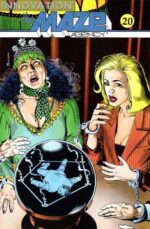 All the stories were written by the series creator Mike W Barr, a self-confessed fan of the genre. The original designs for Jennifer and Gabe were by Alan Davis (who drew the pilot story ‘The Mile-High Corpse’ which eventually surfaced in the Special, having been produced in 1986, two years before issue #1 and as a vehicle for Barr to promote the series to prospective publishers). By the time we got to 1988, the regular pencilling assignment had been allocated to a newcomer by the name of Adam Hughes.
All the stories were written by the series creator Mike W Barr, a self-confessed fan of the genre. The original designs for Jennifer and Gabe were by Alan Davis (who drew the pilot story ‘The Mile-High Corpse’ which eventually surfaced in the Special, having been produced in 1986, two years before issue #1 and as a vehicle for Barr to promote the series to prospective publishers). By the time we got to 1988, the regular pencilling assignment had been allocated to a newcomer by the name of Adam Hughes.
These days Hughes is one of the hottest names in comics; his work (mostly restricted to covers) is avidly collected, and his original art changes hands for small fortunes. Back in 1988 he was an unknown; I remember buying #1 (being a fan of the genre myself) and thinking ‘wow, this artist isn’t bad for an Alan Davis imitator…’ He drew #1-5, #8-9 plus #12 of the original series, plus the short in the TPB ‘Murder In Mint Condition’, originally presented as a promotional copy at the San Diego ComicCon 1988. Back then, kids, you got a whole comic drawn by Hughes! As well as this, he drew many subsequent covers, the last being on issue #3 of the Caliber series. There was a nice bonus in the Comico run in that the back cover featured a Hughes picture advertising the next issue (which wasn’t the cover of the next issue), so you got in effect an extra cover by him. When the series switched to Innovation, the covers changed to appealing wraparounds.
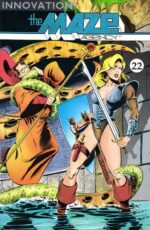 The artwork following Hughes was usually competent, sometimes excellent if seldom spectacular, although there was a fine range of cover artists including Alan Davis, Russ Heath and Brian Bolland. There’s a brief cover gallery included here (from top to bottom): Maze Agency #1 (Comico) by Hughes, #11 (Innovation) by Alan Davis, #13 by Hughes (Jennifer appears as the super-heroine Justice Girl at a fancy dress ball), #20 by Brian Bolland, #22 by J Trent and Jan Duursema (a fantasy sequence in a role-playing game mystery) and #3 (Caliber) by Hughes. A word should also be said in praise of Rick Magyar, whose fine inks adorned the work of Hughes and many other artists on the series.
The artwork following Hughes was usually competent, sometimes excellent if seldom spectacular, although there was a fine range of cover artists including Alan Davis, Russ Heath and Brian Bolland. There’s a brief cover gallery included here (from top to bottom): Maze Agency #1 (Comico) by Hughes, #11 (Innovation) by Alan Davis, #13 by Hughes (Jennifer appears as the super-heroine Justice Girl at a fancy dress ball), #20 by Brian Bolland, #22 by J Trent and Jan Duursema (a fantasy sequence in a role-playing game mystery) and #3 (Caliber) by Hughes. A word should also be said in praise of Rick Magyar, whose fine inks adorned the work of Hughes and many other artists on the series.
 The artwork is a bonus. As a fan of detective fiction myself (from Sherlock Holmes through to Phryne Fisher), I love these stories and the ‘fair play’ challenge of writer Barr to the reader. And I also love the relationship between Jennifer and Gabe, with a tip of the hat to their comic predecessors: Ralph & Sue, Carter & Shiera and Hank & Jan (and if you don’t know who I’m talking about, shame on you!). Can I dare to hope that one day we may yet see the further adventures of the Maze Agency?
The artwork is a bonus. As a fan of detective fiction myself (from Sherlock Holmes through to Phryne Fisher), I love these stories and the ‘fair play’ challenge of writer Barr to the reader. And I also love the relationship between Jennifer and Gabe, with a tip of the hat to their comic predecessors: Ralph & Sue, Carter & Shiera and Hank & Jan (and if you don’t know who I’m talking about, shame on you!). Can I dare to hope that one day we may yet see the further adventures of the Maze Agency?
Rob Rudderham, May 2020
Back to Top
All-American Girl; Marvel Comics’ First Super-Heroine!
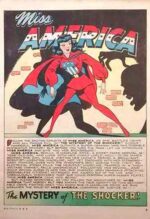 Madeleine Joyce, a.k.a. Miss America, holds a unique position in the Marvel Universe – she’s the first super-powered woman from that company (not then known as Marvel, of course) to don a distinctive costume and battle for the forces of good.
Madeleine Joyce, a.k.a. Miss America, holds a unique position in the Marvel Universe – she’s the first super-powered woman from that company (not then known as Marvel, of course) to don a distinctive costume and battle for the forces of good.
She had two predecessors, of sorts, but one wasn’t super, and the other definitely was no heroine, although she did unwittingly do good things. Zara, a generic, if reasonably modest jungle queen, debuted in Mystic Comics #2 (April 1940), and the decidedly more interesting Black Widow (no relation to Madame Natasha) premiered in Mystic #4 (August 1940), a Satanically resurrected medium who went around slaughtering evil men to consign their souls to Hell.
But it wasn’t until Marvel Mystery Comics #49 (November 1943) that a bona fide super-heroine emerged. Madeline Joyce was a 16-year old orphan living with her late father’s business partner (Child protection laws being hazier back then…) whom she addressed as ‘Uncle Jim’. Uncle Jim takes Maddie to visit a scientist friend – but en route, Madeline’s social warrior bona fides are established when she intervenes as a crippled newsboy is being bullied.
Uncle Jim’s chum, Professor Lawton, explains agitatedly that his invention has gifted him with superhuman strength, the ability to defy gravity, and ‘unusual perception’. Fearing that his old pal’s one issue short of a mini-series, Uncle Jim hastily escorts Madeleine away, but our do-gooding heroine returns late at night to snoop about, and zaps herself with Lawton’s invention. Lawton finds the unconscious girl, and, thinking her dead, remorsefully destroys himself and his machine– but on awakening, Madeleine is gifted with amazing powers, and decides to use them to defend the common man as Miss America!
 Originally those powers were flight, x-ray vision (which could not only penetrate objects, but destroy them), ‘the wisdom of the ages’, and ‘the strength of a thousand men!’, putting our heroine in the Superman class and making her Timely’s most powerful hero by quite a margin. Within a few issues the power set was toned down to flight and some level of physical superiority – enough that she could break ropes and sometimes chains, but could still be overwhelmed by, say, a sneaky blow to the back of the head.
Originally those powers were flight, x-ray vision (which could not only penetrate objects, but destroy them), ‘the wisdom of the ages’, and ‘the strength of a thousand men!’, putting our heroine in the Superman class and making her Timely’s most powerful hero by quite a margin. Within a few issues the power set was toned down to flight and some level of physical superiority – enough that she could break ropes and sometimes chains, but could still be overwhelmed by, say, a sneaky blow to the back of the head.
All of this is pretty standard for the time, but Miss America stood out through her independence. Of an age when she’d be expected to be a sidekick, she was out on her own. She’s often dismissed (even by some sloppy so-called ‘experts’) as a distaff Captain America, but there was no connection between them – they didn’t even meet until three years after her creation – and her power set was both different from and superior to Cap’s. In-story, although nominally the ‘ward’ of her father’s pal Jim, Madeline drove around town on her own, had (at least some of the time) a luxurious penthouse apartment, and lived a remarkably unsupervised life for a minor. And uniquely for a 1940s heroine, there was no boyfriend, no steady, no male authority figure of any kind, and never the remotest hint of romance. Unencumbered by a drippy love interest, she took charge and kicked arse on her own initiative –often with lethal consequences to her foes. Okay, she didn’t actually set out to kill any of them – but if they were collateral damage during battle, she was very much ‘Well, they brought it on themselves’.
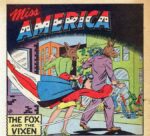 And what villains they were! Yes, the usual thugs, mobsters and con men – often with quite ingenious schemes – but also a variety of strange and disturbing malfeasants with horrific overtones. King Cobra, the Fox and the Vixen, the Black Widow (not that one – no, not that other one, either), the Flaming Hate, the Walking Corpse, Miss Bluebeard, the Ghoul of the 13th Floor, Adonis, the Shocker – all introduced and dispatched in short order, usually in seven pages or less, taut action thrillers that could teach a great many of today’s waddling, flatulent ‘storytellers’ some tricks about moving a plot along!
And what villains they were! Yes, the usual thugs, mobsters and con men – often with quite ingenious schemes – but also a variety of strange and disturbing malfeasants with horrific overtones. King Cobra, the Fox and the Vixen, the Black Widow (not that one – no, not that other one, either), the Flaming Hate, the Walking Corpse, Miss Bluebeard, the Ghoul of the 13th Floor, Adonis, the Shocker – all introduced and dispatched in short order, usually in seven pages or less, taut action thrillers that could teach a great many of today’s waddling, flatulent ‘storytellers’ some tricks about moving a plot along!
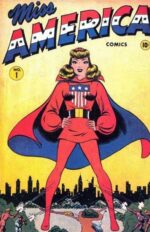
 Within a year Madeline got her own title, and by contemporary accounts Miss America Comics #1 was a huge success. Yet with the second issue, it morphed into Miss America Magazine, a curious amalgam of women’s mag and comic book, with most pages given over to text about fashion, movies and beauty tips. Further, issue #2, despite an unusual photocover of our costumed heroine, carried within it the debut of Patsy Walker, a teen comedy heroine who within a few issues would shoplift Madeleine’s own title away from her! Miss America Magazine continued until the late 1950s – but without Miss America in it!
Within a year Madeline got her own title, and by contemporary accounts Miss America Comics #1 was a huge success. Yet with the second issue, it morphed into Miss America Magazine, a curious amalgam of women’s mag and comic book, with most pages given over to text about fashion, movies and beauty tips. Further, issue #2, despite an unusual photocover of our costumed heroine, carried within it the debut of Patsy Walker, a teen comedy heroine who within a few issues would shoplift Madeleine’s own title away from her! Miss America Magazine continued until the late 1950s – but without Miss America in it!
Miss America solo stories continued to run in Marvel Mystery Comics until #85 (February 1948), as well as occasional guest gigs in other titles such as All-Select and Blonde Phantom. The final ten MMC stories were, unusually for the time, chapters of a tale intended to invoke movie serials, with Madeline recruited by government intelligence to track down a list of Nazi war criminals intercepted by enemy agents.
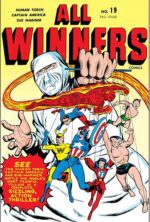 Her highest profile gig, however, was in All-Winners Comics #19 and #21, the only two appearances of the All-Winners Squad, Timely’s attempt at a super-hero team. Alongside Captain America and Bucky, the Human Torch and Toro, the Sub-Mariner and the Whizzer, Miss America faced off against Isbisa and the evil duo of Future Man and Madame Death, acquitting herself admirably.
Her highest profile gig, however, was in All-Winners Comics #19 and #21, the only two appearances of the All-Winners Squad, Timely’s attempt at a super-hero team. Alongside Captain America and Bucky, the Human Torch and Toro, the Sub-Mariner and the Whizzer, Miss America faced off against Isbisa and the evil duo of Future Man and Madame Death, acquitting herself admirably.
With dwindling Post-War interest in super-heroes, the publisher switched tack to other genres – war, crime, romance, horror, western – famously reinventing themselves in 1961 with the publication of Fantastic Four #1 and what would become the Marvel Universe. By 1975, fan-turned-pro Roy Thomas had revived the Cap, Torch and Namor in new WW-II stories as the Invaders, and he followed up with a second team, the Liberty Legion. Miss America was present, but while portrayed as a perfectly competent heroine, the zing and zip of her Golden Age adventures was lacking. Instead of a solo star, she was one of an ensemble, and Thomas having previously romantically linked her and fellow-Legionnaire the Whizzer in a retcon flashback in Giant-Size Avengers #1, her subplots were inevitably pivoted around her boyfriend’s.
 There was one more solo Miss A. adventure, though. In 2009, a Miss America Special was released, along with other ‘new’ Golden Age one-offs to celebrate the company’s 70th Anniversary, and Jen Van Meter and Andy MacDonald provided, in ‘Shipyard Sabotage’, a rollicking retro romp, complete with a United Nations of villainous spy gals!
There was one more solo Miss A. adventure, though. In 2009, a Miss America Special was released, along with other ‘new’ Golden Age one-offs to celebrate the company’s 70th Anniversary, and Jen Van Meter and Andy MacDonald provided, in ‘Shipyard Sabotage’, a rollicking retro romp, complete with a United Nations of villainous spy gals!
Miss America’s place in Marvel history has now been largely usurped by America Chavez, a bisexual Latina heroine from an alternate dimension who was introduced in 2011, and who has become popular through appearances in the Young Avengers and elsewhere. While America Chavez (also sometimes known as Miss America) is a fun character, inventive, ground-breaking and imaginative, it’s a pity that she’s occupied the ‘ecological niche’ of Madeline Joyce to the extent that, when Marvel Comics #1000 was published with a retrospective view of all significant events in Marvel’s history, the page specifically citing Marvel Mystery Comics #49 featured, not Madeline Joyce… but America Chavez.
It’s time to give the gal some respect, Marvel. She was the first costumed heroine of your history, a major player in the 1940s, and, through retcons and flashbacks, still a presence in the Marvel Universe despite the fact she’s been deceased since the 1950s! Give a girl her due.
No harm to America Chavez, but really – isn’t there room in fandom’s heart for two Misses America?
Will Morgan, May 2020
Back to Top
It’s A Jungle Out There: The Story of Lorna the Jungle Girl (sometimes Queen)
Although these days she may be regarded as something of a backwater of the Marvel Universe, Lorna the Jungle Girl was successful enough following her launch in 1953 to sustain a 26 issue series (something many of today’s titles would be proud of). Not that she was truly part of the Marvel Universe, of course; Marvel in those days was known as Atlas, and Lorna is perhaps one of the few characters in Marvel’s history (who had her own title) not to be reinvented in the Silver Age or since.
It was a crowded jungle by the time Lorna found her way into it. Tarzan had boomed on the silver screen long before comics had started up properly, and he wasn’t long in becoming the first of a long line of jungle kings and queens to take up residence in Africa (it’s a good job they didn’t have social distancing then). Sheena (the first female character to get her own series), Rulah, Zago, Zegra, Jo-Jo, White Princess of the Jungle, Kaanga, Judy of the Jungle, Princess Pantha, Camilla, Tiger Girl etc all preceded Lorna. Even within Atlas she had her rivals: Jann of the Jungle, Lo-Zar, Jungle Boy and Leopard Girl. And that’s even without counting other characters whose habitat was the jungle but were less the swinging through the trees dressed in animal skins types, such as the Phantom, Jungle Jim and Nyoka the Jungle Girl. It was a popular place.
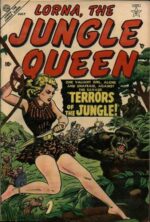 So, what makes Lorna special? Let’s take a look at her debut issue. (The first five issues were entitled Lorna the Jungle Queen before she was ‘dethroned’ (without explanation) for issues #6-26). Lorna was created by writer Don Rico, who wrote all her stories and artist Werner Roth, who drew all the Lorna stories up to #12, with Jay Scott Pike taking over from #13 to the end of the series. In the initial story, rather unimaginatively entitled ‘The Coming Of Lorna’, we are introduced to a white man and his grown daughter. The man is a hunter whose home has been the jungle for 35 years; unfortunately, on the very first page, he is savaged by a lion and sustains injuries from which he eventually dies. His daughter, Lorna, vows to become as great a hunter as her father had been, to compensate for the son he never had, and a friendly native, M’Tuba, volunteers to teach her the skills of spear and knife, assisted by Mikki the monkey. A page later (although in fairness many months have passed), Lorna is ready to adopt an outfit of animal skins (less revealing than many of her jungle ‘siblings’,), but before she can set about putting her skills to use, Lorna and M’Tuba are captured by the notorious Wafisi tribe and taken to their village. Before the apparent cannibalistic ritual, Lorna manages to escape and best the Wafisi witch doctor. She proclaims herself witch doctor, and appoints M’Tuba to rule in her place. The Wafisi tribe hail her as ‘the jungle queen’. Lorna then vows to ‘travel deeper into the jungle… as my father would have wanted me to… to seek out others who may need help!’ M’Tuba gifts her Mikki the monkey, and together girl and monkey ‘walk into the deep shadows of the African jungle… into the mysterious unknown!’
So, what makes Lorna special? Let’s take a look at her debut issue. (The first five issues were entitled Lorna the Jungle Queen before she was ‘dethroned’ (without explanation) for issues #6-26). Lorna was created by writer Don Rico, who wrote all her stories and artist Werner Roth, who drew all the Lorna stories up to #12, with Jay Scott Pike taking over from #13 to the end of the series. In the initial story, rather unimaginatively entitled ‘The Coming Of Lorna’, we are introduced to a white man and his grown daughter. The man is a hunter whose home has been the jungle for 35 years; unfortunately, on the very first page, he is savaged by a lion and sustains injuries from which he eventually dies. His daughter, Lorna, vows to become as great a hunter as her father had been, to compensate for the son he never had, and a friendly native, M’Tuba, volunteers to teach her the skills of spear and knife, assisted by Mikki the monkey. A page later (although in fairness many months have passed), Lorna is ready to adopt an outfit of animal skins (less revealing than many of her jungle ‘siblings’,), but before she can set about putting her skills to use, Lorna and M’Tuba are captured by the notorious Wafisi tribe and taken to their village. Before the apparent cannibalistic ritual, Lorna manages to escape and best the Wafisi witch doctor. She proclaims herself witch doctor, and appoints M’Tuba to rule in her place. The Wafisi tribe hail her as ‘the jungle queen’. Lorna then vows to ‘travel deeper into the jungle… as my father would have wanted me to… to seek out others who may need help!’ M’Tuba gifts her Mikki the monkey, and together girl and monkey ‘walk into the deep shadows of the African jungle… into the mysterious unknown!’
Okay, so as origin stories go, it’s a little lame, unoriginal and not terribly exciting; I mean, she wasn’t bitten by a radioactive snake or had a transfusion of mongoose blood or anything auspicious like that. I don’t know about you, but I often think that can be the way of origin stories, in this case just setting up a series of adventures rather than being a deep and meaningful adventure in itself. The pace picks up a bit in the remaining two stories, with Lorna up against a giant ape and then some white diamond hunters, who end up finding that the mine is in fact the belly of a giant snail (!), and we do mean ‘giant’, roughly the size of a small mountain.
In issue #2, Lorna meets her main squeeze, Greg Knight, a ‘woman-hating hunter’ (because he got thrown over by one once). Lorna is immediately enamoured of him, but his catchphrase turns out to be ‘a jungle is no place for a woman!’ (How ironic… choke). Invariably, for the rest of the series, Greg needs Lorna’s help, although he’ll never admit it. He also gets his own regular strip in the comic without Lorna. And thus the series continued, with familiar jungle tropes of lost civilizations, giant monsters, evil white hunters, natural disasters, hostile natives, sinister doubles, rotten witch doctors etc, etc, all with the same dynamic between Greg and Lorna, which adds some irony and humour to the series (such as when Greg gets outsmarted by Mikki).
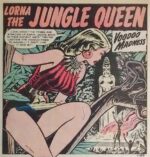 Werner Roth’s Lorna is set in a dark and shadowy jungle, with very effective use of light and shade, a highly imaginative design and style, and a fluidity which belies the stiffness of his later work (as by Jay Gavin) on Marvel’s X-Men. Lorna herself is beautiful, but somehow darkly ethereal and belongs in this jungle world. (Our resident fashion guru, Dr. Evilla, when she was preparing the scans for this article, wondered where Lorna got her hair done and wants the address of that jungle hairdresser.)
Werner Roth’s Lorna is set in a dark and shadowy jungle, with very effective use of light and shade, a highly imaginative design and style, and a fluidity which belies the stiffness of his later work (as by Jay Gavin) on Marvel’s X-Men. Lorna herself is beautiful, but somehow darkly ethereal and belongs in this jungle world. (Our resident fashion guru, Dr. Evilla, when she was preparing the scans for this article, wondered where Lorna got her hair done and wants the address of that jungle hairdresser.)
 Jay Scott Pike’s style was quite different; his jungle was lighter and the art seemed more two-dimensional, lacking the depth and perspective of Roth, but still very competent, with Lorna just as lovely, if somewhat less dark. The tone of the series remained the same, with Rico still scripting.
Jay Scott Pike’s style was quite different; his jungle was lighter and the art seemed more two-dimensional, lacking the depth and perspective of Roth, but still very competent, with Lorna just as lovely, if somewhat less dark. The tone of the series remained the same, with Rico still scripting.
The very final story, in Lorna #26, sees our heroine in the big city and wearing a dress, with Greg assuring her that ‘this is where you belong, Lorna… not in the jungle!’ Following a harrowing rooftop adventure with an escaped ‘night beast’ (part ape, part lion and all demon), Lorna emerges victorious and the creature is captured to be returned to the jungle where it belongs, according to the police. Lorna suggests to Greg that they do too, and Greg has to admit that Lorna is right at last: ‘Back we go!’ And we assume that’s what they did. For Lorna never appeared again. For all we know, she and Greg are there still, in their love/hate relationship, keeping the jungle safe from all manner of stuff.
 Finally, a word about the covers. Neither Roth nor Pike were ever trusted with them, Atlas preferring a whole range of different cover artists: Carl Burgos (including #1), Christopher Rule, Al Hartley, Russ Heath, Harry Anderson, Syd Shores, Joe Maneely, Al Williamson, Vince Colletta and, for five of the last six issues, the wonderful Bill Everett, producing the best artwork on the entire series. We make no apologies for reproducing all five of his covers at the end of this article. A great pity that Everett never got to draw the insides. Although, he kinda did. In Riot #6 (June 1956), Atlas’s Mad-like parody series, Stan Lee himself scripted Loona, the Jungle Girl, a three page pastiche with art by Bill Everett; what might have been (sigh…).
Finally, a word about the covers. Neither Roth nor Pike were ever trusted with them, Atlas preferring a whole range of different cover artists: Carl Burgos (including #1), Christopher Rule, Al Hartley, Russ Heath, Harry Anderson, Syd Shores, Joe Maneely, Al Williamson, Vince Colletta and, for five of the last six issues, the wonderful Bill Everett, producing the best artwork on the entire series. We make no apologies for reproducing all five of his covers at the end of this article. A great pity that Everett never got to draw the insides. Although, he kinda did. In Riot #6 (June 1956), Atlas’s Mad-like parody series, Stan Lee himself scripted Loona, the Jungle Girl, a three page pastiche with art by Bill Everett; what might have been (sigh…).
Still, there’s no denying the appeal of the Lorna series. Less violent and with much better art than the Fox jungle characters, more charm and wit than the Fiction House and Nedor ones, Lorna is my favourite jungle girl.
Rob Rudderham, May 2020
Back to Top
Red Circle Sorcery: Archie’s Best-Kept Secret
 Following certain relaxations of the Comics Code Authority in the late 1960s, comics, led by DC, revisited the defunct horror genre. The precedent, of course, had been set by Warren publishing’s 1964 release of Creepy (to be followed up by Eerie), horror comics anthologies released as larger format black & white magazines, therefore exempt from the Comics Code’s aegis. Their success demonstrated that the audience was still present, and DC editor Joe Orlando, himself an alumnus of the classic EC horror line and a contributor to Creepy et al, seized the opportunity to revive the field in four-colour format.
Following certain relaxations of the Comics Code Authority in the late 1960s, comics, led by DC, revisited the defunct horror genre. The precedent, of course, had been set by Warren publishing’s 1964 release of Creepy (to be followed up by Eerie), horror comics anthologies released as larger format black & white magazines, therefore exempt from the Comics Code’s aegis. Their success demonstrated that the audience was still present, and DC editor Joe Orlando, himself an alumnus of the classic EC horror line and a contributor to Creepy et al, seized the opportunity to revive the field in four-colour format.
Titles such as House of Mystery and House of Secrets, previously devoted for more than a decade to tepid science-fiction or alien/monster/robot tales, returned to chilling form with contributors such as Toth, Wrightson, Adams, Wood and more recreating the suspenseful stories of yesteryear, without the frequently excessive gore and viscera which had caused them to be condemned in the first place. Shortly thereafter, the venerable Unexpected followed suit, to be joined by new titles The Witching Hour and Ghosts, forming the nexus of a horror/mystery line which endured for two decades.
Predictably, other publishers jumped on the bandwagon; Marvel’s Tower of Shadows and Chamber of Darkness were replete with high-quality work from top-notch creators, but the unstoppable demands of the Marvel Superhero Universe meant that within the year Marvel’s horror titles (of which there were many, lasting until the end of the 1970s) became reprints chosen for page length rather than quality.
The eternal also-ran Charlton, however, made a go of it, with multiple titles such as Many Ghosts of Doctor Graves and Ghost Manor running from the late 60s to the early 80s. Their crank-it-out schedule meant there was a terrible lot of trash, but frequent gems also, from Steve Ditko, Tom Sutton, Jim Aparo and early works by Mike Zeck and Don Newton.
In all this sudden flurry, one high quality line of horror/mystery comics crept out all but unnoticed. I, personally, didn’t encounter them until almost a year after they were all over, and having been active in comics fandom since 1972, I really was surprised they got past me.
Darlington, 1976; my first job, working in a book exchange, sorting through the second-hand American comics. In among the interminable Charlton adaptations of unseen TV series, I found a comic entitled Sorcery. Intrigued, I looked through, and saw pages of lovely artwork by Gray Morrow, one of my favourite artists, in a series previously completely unknown to me. These beautifully-drawn, skilfully-told tales of the supernatural easily rivalled the DC mystery line (which by that time was getting rote and repetitive, relying on lesser artists), and I couldn’t believe it had eluded me.
Thus began a quest to ‘catch them all’ – something I only finally achieved in the early days of the 21st century. Not that there are that many – 12, to be exact. But they’re not at all easy to find, and the history is kind of peculiar.
 Dated September and October, 1972, Archie Comics produced a peculiar title: Chilling Adventures In Sorcery, as Told By Sabrina. Yep, that Sabrina, the Teenage Witch. Sabrina was still going great guns in her own Bewitched-esque light comedy title, and had been the star of an animated TV show a few years earlier. But this two-shot title featured Sabrina narrating horror stories – some of them quite strong for Code-approved fare – which were illustrated by Stan Goldberg in the traditional cartoon Archie style, resulting in a cognitive dissonance which is quite unsettling to the viewer.
Dated September and October, 1972, Archie Comics produced a peculiar title: Chilling Adventures In Sorcery, as Told By Sabrina. Yep, that Sabrina, the Teenage Witch. Sabrina was still going great guns in her own Bewitched-esque light comedy title, and had been the star of an animated TV show a few years earlier. But this two-shot title featured Sabrina narrating horror stories – some of them quite strong for Code-approved fare – which were illustrated by Stan Goldberg in the traditional cartoon Archie style, resulting in a cognitive dissonance which is quite unsettling to the viewer.
These two issues sank pretty much without trace. The fact that they were released in consecutive months indicates that they were only ever intended as a ‘tryout’, not intended as ongoing. But a full year later, dated October 1973, saw the release of Chilling Adventures In Sorcery #3, cannily re-purposing an existing title to save copyright licensing fees.
This was a very different series. From the stunning cover, featuring a range of classic horror figures, it was clearly not for the kiddies. Illustrated throughout by Gray Morrow, who also edited the title and pitched the concept, the four stand-alone stories – plus a one-page ‘Essays Into the Supernatural’ feature – were skilful, evocative and haunting. Published under the Red Circle imprint, to differentiate it from the anodyne adventures of Archie et al, the nervous publishers guarded their public image, but committed to further issues.
 And what issues they were. The debut, #3, is the only issue to be drawn entirely by Morrow, but he provided all of the striking covers, plus frequent interior stories. His realistic style was the template – with a handful of exceptions – the naturalistic depiction grounding and adding verisimilitude to the supernatural events. The quality was maintained throughout, with contributors such as veterans Vincente Alcazar, Alex Toth, Doug Wildey, Carlos Pino and Pat Boyette, plus relative newcomers (at that time) Frank Thorne, Howard Chaykin and Bruce Jones.
And what issues they were. The debut, #3, is the only issue to be drawn entirely by Morrow, but he provided all of the striking covers, plus frequent interior stories. His realistic style was the template – with a handful of exceptions – the naturalistic depiction grounding and adding verisimilitude to the supernatural events. The quality was maintained throughout, with contributors such as veterans Vincente Alcazar, Alex Toth, Doug Wildey, Carlos Pino and Pat Boyette, plus relative newcomers (at that time) Frank Thorne, Howard Chaykin and Bruce Jones.
The sso ries suffered from poor distribution even in its native America (and was almost unseen in the UK at the time of release, even more than mainstream Archie’s patchy and highly regional distribution), but nevertheless appears to have been a modest success. Chilling Adventures In Sorcery (which re-tweaked its title into Red Circle Sorcery before finally settling on simply Sorcery) actually gained a companion title, briefly – and that’s another peculiar tale.
Since 1959, Archie’s Madhouse had featured lightweight satire and parody, featuring not only Archie’s Pals N’ Gals, but other recurring characters, such as dollar-store super-hero Captain Sprocket and, most famously, the aforementioned Sabrina, who made her debut in issue #22. It was amiable comedy, trundling innocuously along, a diet-Mad for the younger set.
 Until issue #95 (dated September 1974), when it flipped over into Madhouse, a horror title identical in style and content to Sorcery – which must have been quite a jolt to the parents of young subscribers, especially when #96, with a surprisingly risqué cover for 1974, plopped through the letterbox!
Until issue #95 (dated September 1974), when it flipped over into Madhouse, a horror title identical in style and content to Sorcery – which must have been quite a jolt to the parents of young subscribers, especially when #96, with a surprisingly risqué cover for 1974, plopped through the letterbox!
The ‘horror makeover’ for Madhouse lasted only three issues. With #97, January 1975, Madhouse was cancelled – the same release date as the final issue of Sorcery, #11. Madhouse was actually revived with #98 later in the year, but with the same cartoony parodies as before, the horror interlude determinedly disregarded.
The reasons behind the cancellations have never been quite clear. In the broader market, readers certainly hadn’t turned away from horror – DC’s and Charlton’s mystery lines both thrived into the 1980s. The quality of the titles was, at the time of their release, unmatched. And there must have been some ‘buzz’ around Sorcery to produce a companion title, however short-lived.
One can only speculate that there was a managerial change of heart, possibly in response to reader feedback – maybe the (albeit strategically) topless young lady on Madhouse #96’s cover drew too much ire from Middle America!
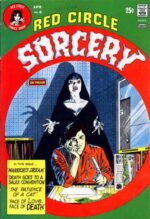
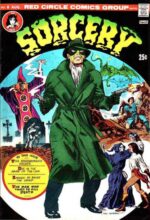 But for 12 issues – Sorcery #3-11, and Madhouse #95-97 – there was briefly a line that matched, if not outstripped, the finest that other publishers of horror/mystery comics were publishing, and it remains, paradoxically, almost unknown even to this day.
But for 12 issues – Sorcery #3-11, and Madhouse #95-97 – there was briefly a line that matched, if not outstripped, the finest that other publishers of horror/mystery comics were publishing, and it remains, paradoxically, almost unknown even to this day.
Will Morgan, May 2020
Back to Top
Reina M. Bull – Mystery 1950s SF Illustrator
I remember coming across the illustrations of Reina M Bull in Brian Aldiss’s lavish 1975 book ‘Science Fiction Art’, wherein two of her magazine covers were reproduced in much larger than life size, almost A3. Both were highly stylised and, as Aldiss put it, carried ‘high sexual charges’. 45 years on, I know little more about her than I did then (which was nothing), but it was probably due to those illustrations in that book that she is chiefly remembered today.
Reina M Bull (born Sington) lived from 1924-2000, but appears only to have been active as an illustrator after the end of the Second World War up to the early 1950s. Ironically, her four covers for New Worlds and Science Fantasy (the British Nova science fiction magazines), as well as being her only entries in the genre, appear to be her last work published. Like her more famous contemporary, Reginald Heade, little is known of her life.



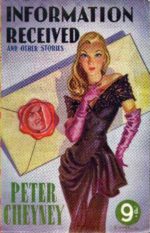 Her early illustrations (as Reina Sington) were for fairy tale books, then later mainly crime covers. Included at this time were works by Agatha Chrstie, Peter Cheyney and Edgar Allan Poe. Later still she provided covers for Mens’ Magazines from Utopia Press with titles like Heebee Jeebee, Hula Hotcha, Fads and Fancies and many others. These were credited as by Janine, presumably to protect her anonymity.
Her early illustrations (as Reina Sington) were for fairy tale books, then later mainly crime covers. Included at this time were works by Agatha Chrstie, Peter Cheyney and Edgar Allan Poe. Later still she provided covers for Mens’ Magazines from Utopia Press with titles like Heebee Jeebee, Hula Hotcha, Fads and Fancies and many others. These were credited as by Janine, presumably to protect her anonymity.
Which brings us to her science fiction covers, all reproduced below. From left to right: New Worlds Autumn 1951 & November 1952, and Science Fantasy Winter 1951/52 & Spring 1952. Both New Worlds and Science Fantasy went on to become the flagship magazines of the British new wave of science fiction in the 1960s, as exemplified by Aldiss, Ballard, Moorcock and many others, but back in the 1950s, edited by John Carnell, they were the British equivalents of the American pulps so prevalent for decades.
Reina Bull had a fluidity of her characters and an angular geometry of her machines and buildings which combined to provide memorable images, typifying the retro futuristic vibe I’ve mentioned in these pages before. The colours are vivid and her people have an alien, almost elfin look. I’ve found the images have stayed with me since I first saw them; perhaps they have a hypnotic or hallucinogenic quality ten or more years ahead of their time. Buyers of these issues will be as delighted as I was when I acquired them to find many interior illustrations by her as well.
If you’re lucky, these can be found still at a few pounds each, a relatively small price to pay for a unique set of classic science fiction art, which only leaves us regretting that Reina Bull didn’t go on to produce more.
Rob Rudderham, April 2020
Back to Top
The ‘WandaMySister’ Years: Best. Avengers. Ever!
In early 1961, Stan Lee was reputedly asked by his publisher, Martin Goodman, to produce a comic book similar to DC’s Justice League of America, a team formed of DC’s major superhero characters, which was going great guns on the nation’s newsstands. Trouble was, Lee’s company – not then known at that point as Marvel Comics – didn’t have any major superhero characters. They had had, back in the 1940s and 1950s, but even their biggest stars – Captain America, the Sub-Mariner and the Human Torch – had been cancelled twice each, and Lee was reluctant to revisit the well for a third attempt. Instead he reinvented the superhero format, creating a dysfunctional family, the Fantastic Four, and, battening on to their success, more hits followed – Spider-Man, Iron Man, Thor – so that, a couple of years later, Lee was in a position to create a team of his major heroes, a true equivalent to DC’s Justice League.
The Avengers, launched in 1963, teamed up Iron Man, Thor, the Hulk and Ant-Man & the Wasp, each of whom was the star of their own solo series. Replacing the early-departing Hulk, whose first run was a surprising flop for Marvel, was Captain America in issue #4, reintroducing the Golden Age hero and giving him a ‘Man Out Of Time’ vibe which resonated with the readership more strongly than a straight revival would have. This stellar team had several epic adventures, and seemed set confidently to rival the JLA in sales and power – but then, with #16, Lee moved the goalposts yet again!
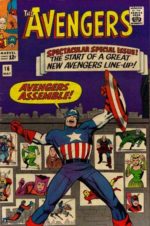 In issue #16, entitled ‘The Old Order Changeth’, Lee sacked four-fifths of the team; it’s easy to see why: Hank & Jan were written out – their strip in Tales to Astonish, having been bitten by a radioactive sales report, was about to be cancelled. But Thor and Iron Man were huge hits, so perhaps Lee (at that stage writing everything, rather than the multiple author & editor set-up over at DC) wanted to focus more on their solo adventures without the distraction of their involvement in the Avengers. In any event, Thor, Iron Man, Giant-Man and the Wasp were replaced by three reformed villains – Hawkeye, who had battled Iron Man on numerous occasions, and Quicksilver & the Scarlet Witch, sibling enemies of the X-Men. It was a ballsy move in story context; Hawkeye was a known thief and Petro and Wanda, recently members in good standing of the Brotherhood of Evil Mutants, were terrorists owing to their association with Magneto. Would the readers accept them as heroes?
In issue #16, entitled ‘The Old Order Changeth’, Lee sacked four-fifths of the team; it’s easy to see why: Hank & Jan were written out – their strip in Tales to Astonish, having been bitten by a radioactive sales report, was about to be cancelled. But Thor and Iron Man were huge hits, so perhaps Lee (at that stage writing everything, rather than the multiple author & editor set-up over at DC) wanted to focus more on their solo adventures without the distraction of their involvement in the Avengers. In any event, Thor, Iron Man, Giant-Man and the Wasp were replaced by three reformed villains – Hawkeye, who had battled Iron Man on numerous occasions, and Quicksilver & the Scarlet Witch, sibling enemies of the X-Men. It was a ballsy move in story context; Hawkeye was a known thief and Petro and Wanda, recently members in good standing of the Brotherhood of Evil Mutants, were terrorists owing to their association with Magneto. Would the readers accept them as heroes?
It was also a daring move commercially; Iron Man and Thor’s presence would have been a huge ‘crossover’ draw to readers. Replacing them with three virtual unknowns – mentored by the remaining Captain America, whose solo feature in Tales of Suspense was less than a year old, and still unproven – could have resulted in the title’s swift demise. Instead, it provided a more intimate dynamic. Freed from the concern of having to co-ordinate the Avenging activities with the solo series, Lee could concentrate more on the character interplay which was his strength. ‘Cap’s Kookie Quartet’ became a faux family a la the Fantastic Four, bickering but loyal to each other, with Hawkeye and Quicksilver butting heads to be the young alpha of the pack, while gradually, in tiny stages, the Scarlet Witch emerged from her brother’s shadow, growing in power and confidence.
 There were flaws, of course; Hawkeye’s constant Johnny-One-Note abrasiveness, ameliorated only occasionally, could become annoying when read in large doses, and Quicksilver’s arrogance begged to be punctured (as well as his inability to address his sister Wanda without adding the explanatory suffix ‘my sister’ – as if either of them was likely to forget that fact! (Granted, Marvel did, but that was decades later…)). And while the Scarlet Witch did come forward during this time, the statement has to be qualified by the observation that it was the early 1960s, and ‘baby steps’ were the order of the day. There were glimpses of her potentially devastating powers, but sadly most of the time, it was still a man telling her when and how to use them. That being said, her effortless takedown in issue #18 of a villain who had defeated all her male colleagues was gratifying.
There were flaws, of course; Hawkeye’s constant Johnny-One-Note abrasiveness, ameliorated only occasionally, could become annoying when read in large doses, and Quicksilver’s arrogance begged to be punctured (as well as his inability to address his sister Wanda without adding the explanatory suffix ‘my sister’ – as if either of them was likely to forget that fact! (Granted, Marvel did, but that was decades later…)). And while the Scarlet Witch did come forward during this time, the statement has to be qualified by the observation that it was the early 1960s, and ‘baby steps’ were the order of the day. There were glimpses of her potentially devastating powers, but sadly most of the time, it was still a man telling her when and how to use them. That being said, her effortless takedown in issue #18 of a villain who had defeated all her male colleagues was gratifying.
Above it all, there was the guiding presence of Captain America, shown not as the gung-ho patriot of his vintage iteration, but as a parental figure, training his protégés, but also evidently caring for them. A man cut away from his own era, the younger Avengers became Cap’s surrogate for the family he might otherwise have had in a kinder world, and it’s a tribute to Lee’s skill as a writer that Cap’s unspoken parental love (tempered with impatience!) for his charges shone through.
 This team’s first objective was to locate and recruit the Hulk, as, lacking the raw power of Thor, Iron Man and Giant-Man, they felt somewhat challenged. But their skills and powers, plus instinctive teamwork, proved more than sufficient to their goals, and the idea of Hulk-wrangling was abandoned by the newly-confident quartet. Together, they faced down some of the Avengers’ greatest enemies: the Enchantress and the Executioner, the villain first known as Power Man, traitorous new recruit the Swordsman, time-travelling tyrant Kang, and the Marvel Universe’ ‘Biggest Bad’, Doctor Doom!
This team’s first objective was to locate and recruit the Hulk, as, lacking the raw power of Thor, Iron Man and Giant-Man, they felt somewhat challenged. But their skills and powers, plus instinctive teamwork, proved more than sufficient to their goals, and the idea of Hulk-wrangling was abandoned by the newly-confident quartet. Together, they faced down some of the Avengers’ greatest enemies: the Enchantress and the Executioner, the villain first known as Power Man, traitorous new recruit the Swordsman, time-travelling tyrant Kang, and the Marvel Universe’ ‘Biggest Bad’, Doctor Doom!
 Stan became a little restless with a ‘second FF’, however, and by issue #26, he began expanding the roster; in that issue, Janet Van Dyne, the Wasp, sought the Avengers’ help, and her size-changing sweetheart followed along soon after, under a new nom du guerre of Goliath. Both rejoined the team, and the cast of characters was expanded further after Roy Thomas took over the scripting with the addition of Hercules, on one of those temporary exiles from paradise that comic-book gods are so fond of. Brash and overwhelming, but benign, Herc filled the ‘raw power’ requirement admirably, while maintaining the focus on interpersonal relationships. And ‘Cap’s Kookie Quartet’ became an effective octet with the increasing involvement of the Black Widow, who had graduated from Iron Man’s femme fatale to Hawkeye’s romantic interest. A bad girl gone good, Natasha’s shadowed past amped up the drama and angst even as she fought alongside the team – her non-Avenger status proving pivotal to the group’s survival at one point. This mix of characters, tensions, and romantic subplots kept the audience enthralled and the sales up without the ‘star power’ of the marquee names.
Stan became a little restless with a ‘second FF’, however, and by issue #26, he began expanding the roster; in that issue, Janet Van Dyne, the Wasp, sought the Avengers’ help, and her size-changing sweetheart followed along soon after, under a new nom du guerre of Goliath. Both rejoined the team, and the cast of characters was expanded further after Roy Thomas took over the scripting with the addition of Hercules, on one of those temporary exiles from paradise that comic-book gods are so fond of. Brash and overwhelming, but benign, Herc filled the ‘raw power’ requirement admirably, while maintaining the focus on interpersonal relationships. And ‘Cap’s Kookie Quartet’ became an effective octet with the increasing involvement of the Black Widow, who had graduated from Iron Man’s femme fatale to Hawkeye’s romantic interest. A bad girl gone good, Natasha’s shadowed past amped up the drama and angst even as she fought alongside the team – her non-Avenger status proving pivotal to the group’s survival at one point. This mix of characters, tensions, and romantic subplots kept the audience enthralled and the sales up without the ‘star power’ of the marquee names.
Sadly, it didn’t endure. Roy Thomas decided to shake matters up in a major way, and with issue #47, Quicksilver and the Scarlet Witch were forcibly recruited by Magneto again – with a head injury to Wanda subsequently rendering her powerless and amnesiac for a tedious subplot. Other characters were introduced in rapid succession – the heroic version of the Black Knight, the Black Panther, the Vision – as the Avengers changed once more, from an intimate ensemble cast with a ‘chosen family’ feel to an association of like-minded colleagues with common goals.
There were many cracking issues in the title’s future, the quality not significantly diminishing until past #100, but the unique dynamic established in #16, while sustainable through cautious expansion, didn’t survive the free for all come’n’go which began with #47.
Recommended issues: Avengers #16 to #46, Annual #1.
Will Morgan, April 2020
Back to Top
Strange Times 2: When Adam Delved
In 1958, DC Comics presented a new science fiction hero, the latest in a line that stretched back to John Carter of Mars and Flash Gordon. Like his famous predecessors, Adam Strange was a contemporary Earthman transported through space for adventures on an alien world. Indeed, the banner heading for Adam’s first appearance in Showcase #17 was ‘Adventures On Other Worlds’ (it wasn’t until #19 that it changed to ‘Adam Strange’, the one and only time in the classic Silver Age that his name appeared at the masthead on a comic cover, since all subsequent appearances came in Mystery In Space).
Adam Strange was created by editor Julius Schwartz and (visually) Murphy Anderson. It was Schwartz (himself a veteran of science fiction magazines) who conceived the idea of an Earthman repeatedly traveling to a planet in the Alpha Centauri star system using a ‘Zeta-Beam’. Since Adam Strange was the first Earthman on another planet, he named his character Adam after the Biblical first man. Schwartz assigned the scripts to Gardner Fox (although the plots were dreamed up between them) and the artistic duties to Mike Sekowsky. Schwartz, being a science major, gave Fox scientific pointers which lent the series a plausibility far greater than other science fiction comics of the time.
 In Showcase #17, Adam Strange is presented as an archaeologist, an Indiana Jones-type figure searching for a lost city of the Incas in the Andes. Pursued by natives, he risks a twenty-five foot leap across a chasm, but never lands. Instead he is struck by a mysterious beam from space and transported to the planet Rann of the star system Alpha Centauri 25 trillion miles from Earth. There he meets the lovely Alanna and her scientist father Sardath in the city of Ranagar. They explain that their ‘Zeta-Beam’ was a communication device sent to Earth four years previously in an attempt to establish contact; due to some unnamed ‘space radiation’, they postulated that the beam had somehow been converted into a teleportation beam. No sooner is Adam starting to settle in than Rann is invaded by a race called the Eternals (!) who are after a rare metal for their home world. Using his spacecraft piloting skills (where did he get those from?) and his wits, Adam is able to trap the Eternals permanently in the fourth dimension, as you do. Just as he succeeds, however, the Zeta-Beam charge wears off and he is teleported back to Earth.
In Showcase #17, Adam Strange is presented as an archaeologist, an Indiana Jones-type figure searching for a lost city of the Incas in the Andes. Pursued by natives, he risks a twenty-five foot leap across a chasm, but never lands. Instead he is struck by a mysterious beam from space and transported to the planet Rann of the star system Alpha Centauri 25 trillion miles from Earth. There he meets the lovely Alanna and her scientist father Sardath in the city of Ranagar. They explain that their ‘Zeta-Beam’ was a communication device sent to Earth four years previously in an attempt to establish contact; due to some unnamed ‘space radiation’, they postulated that the beam had somehow been converted into a teleportation beam. No sooner is Adam starting to settle in than Rann is invaded by a race called the Eternals (!) who are after a rare metal for their home world. Using his spacecraft piloting skills (where did he get those from?) and his wits, Adam is able to trap the Eternals permanently in the fourth dimension, as you do. Just as he succeeds, however, the Zeta-Beam charge wears off and he is teleported back to Earth.
Never fear though because Sardath had previously been able to advise where and when all subsequent Zeta-Beams would strike the Earth (they took four years, but he’d already sent loads!), so Adam was able to beam back to Rann in time for his second adventure and the second alien invasion in the second story in Showcase #17, wherein Adam got the spacesuit, rocket jets and ray-gun by which we came to recognise him.

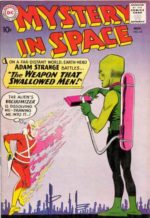
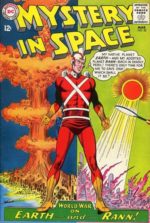 And so it went. Adam Strange had three more ‘try-outs’ in Showcase before being ‘promoted’ to his own series in Mystery In Space, commencing with issue #53 in August 1959. By this time, Schwartz has assigned the pencilling of the strip to Carmine Infantino, whose alien, futuristic cityscapes gave a unique feel to the series and proved a match made in heaven with Fox’s scripts and Schwartz’s editing/co-plotting. Alanna by this time had adopted the yellow and blue outfit she is most famous for, and looked more gorgeous than ever. The run with Schwartz at the helm and his key team in place (more than ably assisted by the wonderful Murphy Anderson inking on most issues) lasted until Mystery In Space #91. Almost invariably, the plot would involve a menace to Rann coinciding with Adam’s arrival, and he was Rann’s champion, overcoming the odds by means of his wits, logic, intelligence and scientific knowledge (as well as his handy ray-gun, of course). As soon as the threat was over and Adam was all set to get some snuggly time with Alanna, the Zeta-Beam energy would wear off as he was drawn back to Earth. There were variations, of course; we saw something of Adam’s life on Earth, both his archaeology and his high standing in terms of the New York museum where a wing named after him was opening. There were some stories that featured a degree of adventure on Earth, including a visit by Alanna. Story lengths varied too, from being about one third of the comic to full-length tales. There were also some great covers. I would have loved to have been a fly on the wall in Schwartz’s office when he and Fox were coming up with the plots. I’m sure Schwartz had a habit of dreaming up the covers and saying to Fox “Here you go, write a story around that!” (Consider #63, where Adam is being vacuumed up by an alien with, well, what looks like a vacuum cleaner). Then there was the beautiful grey tone cover to #55, the classic split-cover #82, depicting world war on Earth & Rann, and many others.
And so it went. Adam Strange had three more ‘try-outs’ in Showcase before being ‘promoted’ to his own series in Mystery In Space, commencing with issue #53 in August 1959. By this time, Schwartz has assigned the pencilling of the strip to Carmine Infantino, whose alien, futuristic cityscapes gave a unique feel to the series and proved a match made in heaven with Fox’s scripts and Schwartz’s editing/co-plotting. Alanna by this time had adopted the yellow and blue outfit she is most famous for, and looked more gorgeous than ever. The run with Schwartz at the helm and his key team in place (more than ably assisted by the wonderful Murphy Anderson inking on most issues) lasted until Mystery In Space #91. Almost invariably, the plot would involve a menace to Rann coinciding with Adam’s arrival, and he was Rann’s champion, overcoming the odds by means of his wits, logic, intelligence and scientific knowledge (as well as his handy ray-gun, of course). As soon as the threat was over and Adam was all set to get some snuggly time with Alanna, the Zeta-Beam energy would wear off as he was drawn back to Earth. There were variations, of course; we saw something of Adam’s life on Earth, both his archaeology and his high standing in terms of the New York museum where a wing named after him was opening. There were some stories that featured a degree of adventure on Earth, including a visit by Alanna. Story lengths varied too, from being about one third of the comic to full-length tales. There were also some great covers. I would have loved to have been a fly on the wall in Schwartz’s office when he and Fox were coming up with the plots. I’m sure Schwartz had a habit of dreaming up the covers and saying to Fox “Here you go, write a story around that!” (Consider #63, where Adam is being vacuumed up by an alien with, well, what looks like a vacuum cleaner). Then there was the beautiful grey tone cover to #55, the classic split-cover #82, depicting world war on Earth & Rann, and many others.
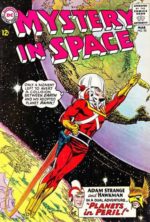
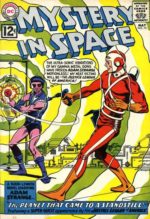 My absolute favourite cover though came on #90, which depicts Adam jetting between Rann & Earth when they are on a collision course. The full-length story to this guest stars Hawkman and Hawkgirl and is one of my all-time favourite comics. It’s also worth singling out the award-winning #75, guest-starring the Justice League of America. This came about because the JLA in their own title were depicted discussing Adam for membership, so it was decided that the adventure where they had met him ought to be told. ‘The Planet That Came To A Standstill’ featured the menace of Kanjar Ro, in a comic that has been dubbed Justice League #3.5, since it took place after the JLA’s clash with that villain in #3 of their own title. I’ve every admiration for the JLA’s regular penciller Mike Sekowsky, but the JLA drawn by Infantino and Anderson here made me really wish they’d been drawing the JLA as well. In those days, crossovers were very special, and #75 and #90 were both landmark issues. There’s one other crossover worth noting: Adam and Alanna played a major role in Hawkman #18 (and a minor one in #19) in 1967, both by Fox and Anderson and totally in keeping with Adam’s own series.
My absolute favourite cover though came on #90, which depicts Adam jetting between Rann & Earth when they are on a collision course. The full-length story to this guest stars Hawkman and Hawkgirl and is one of my all-time favourite comics. It’s also worth singling out the award-winning #75, guest-starring the Justice League of America. This came about because the JLA in their own title were depicted discussing Adam for membership, so it was decided that the adventure where they had met him ought to be told. ‘The Planet That Came To A Standstill’ featured the menace of Kanjar Ro, in a comic that has been dubbed Justice League #3.5, since it took place after the JLA’s clash with that villain in #3 of their own title. I’ve every admiration for the JLA’s regular penciller Mike Sekowsky, but the JLA drawn by Infantino and Anderson here made me really wish they’d been drawing the JLA as well. In those days, crossovers were very special, and #75 and #90 were both landmark issues. There’s one other crossover worth noting: Adam and Alanna played a major role in Hawkman #18 (and a minor one in #19) in 1967, both by Fox and Anderson and totally in keeping with Adam’s own series.
Sadly, all good things come to an end. After Mystery In Space #91, Schwartz was switched to editing the Batman titles and his chosen writers and artists went with him. The Adam Strange strip limped on for a further ten or so issues with lesser hands at the tiller; suffice it to say that we don’t need to concern ourselves with those here. Nor do we really need to consider the many appearances of Adam Strange in the DC universe since then (he’s still around today). The purist in me rebels at what has been done with the mythos, particularly in regard to Rann, so we won’t dwell on that here.
What remains as essential reading is Showcase #17-19 and Mystery in Space #53-91, each one a gem of comic story-telling. Okay, so the stories are formulaic, calling on many classic science fiction tropes and there is little in the way of development, but if you’ve got a winning formula and it ain’t broke, don’t fix it; the stories were created by the finest craftsmen then working in comics, IMHO. Adam Strange remains an absolute favourite of mine, an intelligent hero, a science fiction character and not a super-hero, using his wits and ingenuity to overcome a different threat eight times a year (the MIS publication schedule) as I grew up alongside him in those early 1960s.
Next time you’re out for your daily exercise, look up. Is it a bird? Is it a plane? No, but it might just be Adam Strange, catching that Zeta-Beam to Rann one last time.
Rob Rudderham, April 2020
Back to Top
Sandra & Magi: The Only Excuse For Lucy Lane
Jimmy Olsen’s Silver Age stories were 95% drivel.
Oh, entertaining enough drivel – they were fun nonsense, suggesting that a short ginger freckle-faced junior reporter could also have an international (nay, interplanetary) fan club, and be irresistible to ladies from outer space, other dimensions and beyond the realms of time. You had to turn your brain off when you went into Jimmy’s world, but the amusement value was generally worth it, with their dream-logic, barely coherent and thoroughly bizarre events.
Jimmy was vain, impulsive, and overconfident, socially maladroit while considering himself sophisticated, yet loyal, brave, resourceful and compassionate; a self-contradictory ‘everyman’ and identification figure perhaps a decade older than his intended readership. The impressions of adult life – especially of romantic relationships – that young readers received were peculiar, mind. Every one-shot love interest introduced for Jimmy turned out to be an alien, villain, robot or some combination of the above.
But in Jimmy Olsen #36 (April 1959) we were introduced to Lucy Lane, younger sister of Lois, an air hostess who rapidly became Jimmy’s steady. And he, and the readers, found out what a REAL monster was like!
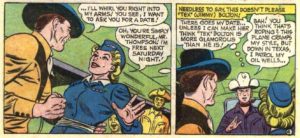 In that first story, Lucy was simply presented as fickle and thoughtless. She broke a date with Jimmy four times when a ‘better prospect’ came along – two rodeo stars (one of whom was a disguised Jimmy), a scientist and a robot (also a disguised Jimmy – look, just go with it, all right?) Four times she attempted to ‘trade up’ for one date on the same night. In a nine-page story!
In that first story, Lucy was simply presented as fickle and thoughtless. She broke a date with Jimmy four times when a ‘better prospect’ came along – two rodeo stars (one of whom was a disguised Jimmy), a scientist and a robot (also a disguised Jimmy – look, just go with it, all right?) Four times she attempted to ‘trade up’ for one date on the same night. In a nine-page story!
Then… things got worse. Persuaded to become Jimmy’s steady girl, but unable to marry him because she’d promised her parents she wouldn’t wed until her older sister, Lois, became Mrs. Superman (good luck with that), Lucy just hung around like a bad smell, frequently dumping our hero for more eligible prospects, nagging, belittling, criticizing, ridiculing and being a major drag. Granted, Jimmy was a well-meaning doofus, but he didn’t deserve this kind of abuse.
The reason for Lucy’s introduction is easy to deduce. In 1954 when Jimmy’s solo series launched, comics were still reeling from the accusations of Doctor Frederic Wertham, the psychologist who decried comic books as hotbeds of juvenile delinquency and social and sexual deviation, including homosexuality. Jimmy’s relationship with Superman in the early years of his series was half surrogate father/son, half hero-worshipping man-crush. All completely innocent, but the editors got twitchy enough of appearances that a regular girlfriend for Jimmy was mandated.
But even the much-decried Lois Lane and Lana Lang behaved better than Lucy; while they were portrayed as ‘rash’ and ‘impulsive’ and ‘hysterical’ and all the other sexist Silver Age euphemisms for ‘irrational because they menstruate’, they also were permitted to display courage, loyalty and ingenuity from time to time. Readers only ever got to see the bad side of Lucy – to the point where when she was kidnapped and used as a ‘damsel in distress’ prop, it was actually a relief!
Except in three stories. Well, they all could be taken as chapters of the same story, though they were separated in time, both real and comic-book time.
 We open with Jimmy Olsen #74 (January 1964) and ‘Jimmy Olsen’s Secret Love’. By a startling coincidence – it says so, right there in the captions – both Jimmy and Lucy are assigned undercover assignments by their employers. Jimmy is told a jewel thief will be on a particular flight. Lucy, meanwhile, is what would now be called a ‘mystery shopper’, ratting out her colleagues – er, travelling as a regular passenger to check on standards. Each assumes a disguise to avoid being recognized. Lucy becomes the red-haired actress ‘Sandra Rogers’, and Jimmy, somewhat misinterpreting the meaning of ‘undercover’, dons an attention-getting tuxedo ensemble as stage magician ‘Magi’. By startling coincidence – told you so – the disguised pair are seated next to each other, and following some getting-to-know-you chit chat – during which ‘Sandra’, expresses the opinion Jimmy Olsen is over-rated and too dependent on Superman, and ‘Magi’ expresses a distaste for blondes, each cementing the other’s resolve not to come clean – a fuel leak strands the plane on an ice floe, and the pair kiss passionately and fall in love under the prospect of imminent death. Rescued by Superman – who also scoops up the jewel thief (remember him?) – the pair are separated in the excitement, and wonder if they will ever meet again. Just as well they didn’t have Google in those days!
We open with Jimmy Olsen #74 (January 1964) and ‘Jimmy Olsen’s Secret Love’. By a startling coincidence – it says so, right there in the captions – both Jimmy and Lucy are assigned undercover assignments by their employers. Jimmy is told a jewel thief will be on a particular flight. Lucy, meanwhile, is what would now be called a ‘mystery shopper’, ratting out her colleagues – er, travelling as a regular passenger to check on standards. Each assumes a disguise to avoid being recognized. Lucy becomes the red-haired actress ‘Sandra Rogers’, and Jimmy, somewhat misinterpreting the meaning of ‘undercover’, dons an attention-getting tuxedo ensemble as stage magician ‘Magi’. By startling coincidence – told you so – the disguised pair are seated next to each other, and following some getting-to-know-you chit chat – during which ‘Sandra’, expresses the opinion Jimmy Olsen is over-rated and too dependent on Superman, and ‘Magi’ expresses a distaste for blondes, each cementing the other’s resolve not to come clean – a fuel leak strands the plane on an ice floe, and the pair kiss passionately and fall in love under the prospect of imminent death. Rescued by Superman – who also scoops up the jewel thief (remember him?) – the pair are separated in the excitement, and wonder if they will ever meet again. Just as well they didn’t have Google in those days!
It’s lightweight – that goes with the territory – but the banter between the two carries a surprising level of maturity, as each realizes – after an obligatory qualm that they’re being ‘untrue’ – that their assumed personae are giving them a chance to relax from the pressures and expectations of their daily lives. Each feels, at least temporarily, that they’re better off as their fake selves than the real, and enjoy the break – well, until the plane crash, obviously.
 The readership was asked at the end of the story if they’d like to see Sandra and Magi meet again – and apparently they did, as Jimmy Olsen #78 (July 1964) brought ‘The Return of Jimmy’s Lost Love.’ Lucy and Jimmy’s relationship is in freefall, as each is preoccupied with memories of Magi and Sandra, respectively. Gaining another undercover assignment, to investigate Air Mail theft, Lucy disguises herself again as Sandra, for sentimental reasons. Glimpsing ‘Sandra’ at the airport, Jimmy, with a disguise trunk in his luggage, scrambles together a ‘Magi’ outfit and stages a reconciliation, including ‘compelling’ Superman to appear. (Superman, knowing Jimmy is ‘Magi’, obliges his pal. But Supes doesn’t know Lucy is ‘Sandra’, so really he’s just helping Jimmy two-time his girlfriend with some random hot chick! Told you Lucy didn’t win any friends…)
The readership was asked at the end of the story if they’d like to see Sandra and Magi meet again – and apparently they did, as Jimmy Olsen #78 (July 1964) brought ‘The Return of Jimmy’s Lost Love.’ Lucy and Jimmy’s relationship is in freefall, as each is preoccupied with memories of Magi and Sandra, respectively. Gaining another undercover assignment, to investigate Air Mail theft, Lucy disguises herself again as Sandra, for sentimental reasons. Glimpsing ‘Sandra’ at the airport, Jimmy, with a disguise trunk in his luggage, scrambles together a ‘Magi’ outfit and stages a reconciliation, including ‘compelling’ Superman to appear. (Superman, knowing Jimmy is ‘Magi’, obliges his pal. But Supes doesn’t know Lucy is ‘Sandra’, so really he’s just helping Jimmy two-time his girlfriend with some random hot chick! Told you Lucy didn’t win any friends…)
The pair end up helpless as the Air Mail thief – remember him? –is about to gun them down when a contrived coincidence brings Superman to the rescue. Realising the depths of their feelings for each other, ‘Sandra’ and ‘Magi’ also contemplate the inevitable consequences of continuing their relationship – that the truth would out, eliciting an angry rejection. In a surprising display of maturity for a Mort Weisinger comic, each realizes that they must part, and making excuses, they walk away. But when Jimmy and Lucy meet again as themselves, each still has their mind on their lost love who never existed.
The serial was resolved in Jimmy Olsen #82 (January 1965), ‘The Wedding of Sandra and Magi!’ Still dwelling on her feelings for ‘Magi’, Lucy becomes ‘Sandra’ once more and walks around her neighbourhood, reminiscing. By that coincidence again, Jimmy drives by, and seeing ‘Sandra’, can’t resist assuming his ‘Magi’ identity – just in time to save ‘Sandra’ from a mugger! After the thrill of their reunion, however, each has misgivings. Knowing that continuing the relationship would bring exposure, Lucy decides not to see ‘Magi’ again, while Jimmy takes it one step further, faking ‘Magi’s’ death during an heroic rescue!
 Depressed and distraught, Jimmy and Lucy ‘settle’, and agree to marry. Yet after the ceremony (but before the wedding night, courtesy of the Comics Code) each decides to break off the marriage. Lucy, leaving a note on Jimmy’s disguise trunk, decides to take a look through for old time’s sake. Guess what she finds? Bits and pieces of ‘Magi’! Showing up for dinner in a red wig, Lucy lets Jimmy know she knows, and in a food fight, the truth is revealed, and the couple’s rage turns to laughter at the absurdity of the situation, as they realize they were in love with each other all along!
Depressed and distraught, Jimmy and Lucy ‘settle’, and agree to marry. Yet after the ceremony (but before the wedding night, courtesy of the Comics Code) each decides to break off the marriage. Lucy, leaving a note on Jimmy’s disguise trunk, decides to take a look through for old time’s sake. Guess what she finds? Bits and pieces of ‘Magi’! Showing up for dinner in a red wig, Lucy lets Jimmy know she knows, and in a food fight, the truth is revealed, and the couple’s rage turns to laughter at the absurdity of the situation, as they realize they were in love with each other all along!
Owing to Plot Contrivance, the Justice of the Peace who wedded them turns up just in time to let the couple know his license has expired – they’re not married! Smiling, Lucy and Jimmy agree to stay single, but to continue their relationship in this new spirit of openness and support.
Well, until the next story, when all was forgotten, and Lucy was back to her standard role as perma-grumpy trolley dolly, vicious, selfish and tyrannical as ever.
But for those three stories, there was a reason for Lucy Lane. Instead of serving as a rubber-stamp for heterosexuality, she was given something to actually DO other than be a nag or a drag, and a fleeting chance to display some warmth, intelligence and humour. All three of these stories are attributed to Jerry Siegel, surprisingly, as he’s not known for subtle scripting. While they rely on contrived coincidences and ridiculous situations – they are, after all, 1960s Superman Family tales – they display a surprising emotional range at a time when that wasn’t fashionable. The art on all three, serendipitously, is by Curt Swan, whose mastery of facial expressions perfectly suits the conflicted feelings of the protagonists. None of the other regular Jimmy artists could have done it; John Forte and Al Plastino, no harm to them, simply wouldn’t have been up to the job, and even the superlative Kurt Schaffenberger would have broadened the comedy, diluting the bittersweet appeal of these tales.
So there we are; the only three stories that truly justify the otherwise tedious, spiteful existence of Lucy Lane.
Will Morgan, April 2020
Back to Top
Strange Times: The Doctor Is In
This week we pay tribute to a fictional heroic Doctor, while the real doctors are the real heroes in these strange times.
At the time that Stan Lee and Jack Kirby were populating the pre-hero Marvel Universe with Big Panty Monsters (some of whom – Fin Fang Foom and Groot, to name but two – went on to bigger things than just menacing the world), Stan was creating little magical, fantastical short stories with Steve Ditko, whose sometime whimsical style was ably suited to the genre (see Amazing Fantasy, for example). Small wonder then, that when it came to creating a magical super-hero to join the burgeoning Marvel panoply, Sturdy Steve Ditko was the artist/co-creator. Actually, the story goes that Ditko had the concept for the character and got Lee to provide the scripts.
Now, Dr. Strange is a major Marvel character; he’s been around for decades and had a film not too long ago, so I’m guessing you all know his story. Egotistical surgeon; car crash; damaged hands; Tibetan monastery; student of the Ancient One; Master of the Mystic Arts…
 Dr Strange first appeared in Strange Tales #110 (July 1963), in a five page back-up where he was already established as a practitioner of ‘black magic’. In this first adventure he encounters Nightmare, his ‘ancient foe’ and calls upon the Ancient One for help; Strange’s man servant Wong also appears in this issue but is not named until #119. Thus we can assume that Strange has already been around for a while. In the second equally short story in #111, we encounter Baron Mordo, Strange’s arch-nemesis and the Ancient One’s other student turned bad. After a two issue gap, a further clash with Mordo occurs in #114, wherein we also meet potential novice Victoria Bentley for the first time. It’s not until #115 that we learn the origin of Dr Strange, as his series gets promoted to eight pages.
Dr Strange first appeared in Strange Tales #110 (July 1963), in a five page back-up where he was already established as a practitioner of ‘black magic’. In this first adventure he encounters Nightmare, his ‘ancient foe’ and calls upon the Ancient One for help; Strange’s man servant Wong also appears in this issue but is not named until #119. Thus we can assume that Strange has already been around for a while. In the second equally short story in #111, we encounter Baron Mordo, Strange’s arch-nemesis and the Ancient One’s other student turned bad. After a two issue gap, a further clash with Mordo occurs in #114, wherein we also meet potential novice Victoria Bentley for the first time. It’s not until #115 that we learn the origin of Dr Strange, as his series gets promoted to eight pages.
From there on, Dr. Strange appeared in every issue of Strange Tales, initially backing-up the Human Torch/Torch and Thing stories until #134 and then sharing the comic with Nick Fury, Agent of SHIELD until the final issue #168. To begin with, there were lovely little self-contained stories: a re-match with Nightmare, adventures in other dimensions, a haunted house, a wax museum, an encounter with Loki (perhaps easy to see why Ditko wasn’t drawing Thor!), a story with Cleopatra as the mysterious ‘Lady From Nowhere’, and numerous clashes with Baron Mordo. It wasn’t until #117 that Strange was even mentioned on the cover of Strange Tales, and he rarely had more than a small cover space devoted to his strip until, ironically, #146 and Ditko’s last Dr. Strange story.
 Gradually, we readers realised, with the introduction of the supremely powerful Dormammu and Clea, Strange’s partner-to-be in #126 that we had embarked upon a Grand Adventure that would last nearly two years. Dormammu and his dark dimension had been mentioned prior to his appearance, as one of the many mystic-sounding words that Dr. Strange used in his vocabulary (cf. the ‘Hoary Hosts of Hoggoth’, the’ Sons Of Satannish’ etc), but, as Lee put it, the readers were intrigued and he had to make up a character to go with the name. The flame-headed demon-like lord of an alien dimension thus made his debut, with a plan to invade and conquer our dimension (hey, no different to any other super-villain then?). There were a couple of diversions before the epic storyline of Dr Strange vs Dormammu began in earnest in Strange Tales #130 and lasted until Ditko’s last story in #146. Using Mordo as his pawn, Domammu plotted to defeat Dr.
Gradually, we readers realised, with the introduction of the supremely powerful Dormammu and Clea, Strange’s partner-to-be in #126 that we had embarked upon a Grand Adventure that would last nearly two years. Dormammu and his dark dimension had been mentioned prior to his appearance, as one of the many mystic-sounding words that Dr. Strange used in his vocabulary (cf. the ‘Hoary Hosts of Hoggoth’, the’ Sons Of Satannish’ etc), but, as Lee put it, the readers were intrigued and he had to make up a character to go with the name. The flame-headed demon-like lord of an alien dimension thus made his debut, with a plan to invade and conquer our dimension (hey, no different to any other super-villain then?). There were a couple of diversions before the epic storyline of Dr Strange vs Dormammu began in earnest in Strange Tales #130 and lasted until Ditko’s last story in #146. Using Mordo as his pawn, Domammu plotted to defeat Dr.  Strange, the only obstacle to his plans. Strange is both hunter and hunted as Dormammu, through Mordo, chases him across the Earth and mystical dimensions, while Strange seeks the secret of the mysterious Eternity to learn how to defeat Dormammu. While in the Dark Dimension, a helpless Clea watches on. Eventually, it all boils down to single combat in the Dark Dimension; Strange wins, having previously been given advice by the enigmatic, god-like Eternity (a character of striking visual appearance, a silhouette with the cosmos inside him – see the cover of Strange tales #146), only for Dormammu to go back on his word to forsake his conquest of our dimension; Strange continues to be menaced by Dormammu’s pawns, and Clea is banished for helping him. Finally, in Strange Tales #146, Dorammmu takes on Eternity himself in a bid for power, but is defeated and banished, releasing Clea, and the epic, and Steve Ditko’s run on the character he created both come to an end.
Strange, the only obstacle to his plans. Strange is both hunter and hunted as Dormammu, through Mordo, chases him across the Earth and mystical dimensions, while Strange seeks the secret of the mysterious Eternity to learn how to defeat Dormammu. While in the Dark Dimension, a helpless Clea watches on. Eventually, it all boils down to single combat in the Dark Dimension; Strange wins, having previously been given advice by the enigmatic, god-like Eternity (a character of striking visual appearance, a silhouette with the cosmos inside him – see the cover of Strange tales #146), only for Dormammu to go back on his word to forsake his conquest of our dimension; Strange continues to be menaced by Dormammu’s pawns, and Clea is banished for helping him. Finally, in Strange Tales #146, Dorammmu takes on Eternity himself in a bid for power, but is defeated and banished, releasing Clea, and the epic, and Steve Ditko’s run on the character he created both come to an end.
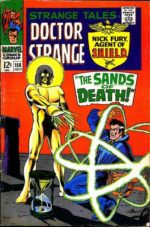 By this time, Stan Lee had turned over the scripting to Denny O’Neill, though it is believed a lot of the plotting was down to Ditko. After Ditko, the strip fell into the more than capable hands of Bill Everett, Marie Severin and Dan Adkins, passing to Roy Thomas & Gene Colan when Strange Tales was re-branded as Dr. Strange for issues #169-183, being the first time the character had his own title. Many memorable characters were introduced in that period – Umar (sister of Dormammu), Zom, Nebulos (Lord of the Planets Perilous) and, in particular, the Living Tribunal, a multi-faced giant with no neck and a floating head, who oversees the balance of all things in the Marvel Universe and is, allegedly, the supreme power in it (I expect there’s one or two others who might dispute that claim). The Living Tribunal has, of course, gone on to become a major player in Marvel’s cosmic mythos. This period also saw the return of Victoria Bentley.
By this time, Stan Lee had turned over the scripting to Denny O’Neill, though it is believed a lot of the plotting was down to Ditko. After Ditko, the strip fell into the more than capable hands of Bill Everett, Marie Severin and Dan Adkins, passing to Roy Thomas & Gene Colan when Strange Tales was re-branded as Dr. Strange for issues #169-183, being the first time the character had his own title. Many memorable characters were introduced in that period – Umar (sister of Dormammu), Zom, Nebulos (Lord of the Planets Perilous) and, in particular, the Living Tribunal, a multi-faced giant with no neck and a floating head, who oversees the balance of all things in the Marvel Universe and is, allegedly, the supreme power in it (I expect there’s one or two others who might dispute that claim). The Living Tribunal has, of course, gone on to become a major player in Marvel’s cosmic mythos. This period also saw the return of Victoria Bentley.
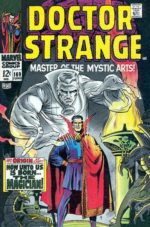 Dr. Strange was revived again in the 1970s and many times since, nearly always blessed with fine artists at the helm. Perhaps he’s a character, and his world a concept, that brings out the best. Undoubtedly, it’s the legacy of Ditko, whose surrealistic imagery defined the series, giving it a hallucinogenic, psychedelic quality by virtue of its bizarre landscapes and twisting dimensions. Add to that Lee’s cod Eastern mysticism and you have a strip that truly tapped into, if not pre-dated, the zeitgeist of the time, the counter culture of the beat generation and the psychedelia of the hippie movement. Unsurprisingly, Dr. Strange was a highly popular character in colleges across the USA and UK. I doubt that Lee and Ditko were on anything when they wrote and drew the series, but it sure read that way.
Dr. Strange was revived again in the 1970s and many times since, nearly always blessed with fine artists at the helm. Perhaps he’s a character, and his world a concept, that brings out the best. Undoubtedly, it’s the legacy of Ditko, whose surrealistic imagery defined the series, giving it a hallucinogenic, psychedelic quality by virtue of its bizarre landscapes and twisting dimensions. Add to that Lee’s cod Eastern mysticism and you have a strip that truly tapped into, if not pre-dated, the zeitgeist of the time, the counter culture of the beat generation and the psychedelia of the hippie movement. Unsurprisingly, Dr. Strange was a highly popular character in colleges across the USA and UK. I doubt that Lee and Ditko were on anything when they wrote and drew the series, but it sure read that way.
Quite literally, worlds away from Stan’s and Steve’s other creation (but see the superb team-up in Amazing Spider-Man Annual #2). By the Ragged Rings of Raggadorr, may the book of the Vishanti always be open for your all-seeing Eye of Agamotto!
Rob Rudderham, April 2020
Back to Top
Sally Forth! Remembering the UK’s ‘comic for the adventurous girl’
For many years, the field of girls’ weekly comics has been unjustly ignored. These weeklies, which enthralled (and arguably helped to brainwash) generations of girls (and more than a few furtive boys) sold in the hundreds of thousands, every week, capturing huge audiences, but in the field of British comics studies the focus has been on the boys’ weeklies or the funnies – Eagle, 2000 AD, Beano, ad infinitum.
Over the last decade and a half, several writers – Melanie Gibson, Jenni Scott, Julia Round –are mercifully bucking this trend, appreciating the high levels of craftsmanship and storytelling on the distaff side of the market, but even they haven’t yet paid much attention to one of the most sought-after – if sales in our shop are any indication – girls’ weeklies of all.
The first issue of Fleetway/IPC’s Sally was dated 14th June 1969, but it had been heavily teased in pre-launch adverts as the “comic for the adventurous girl”, and the editors seemed very conscious that they were trying out a different direction. Yes, the usual elements were present of struggling orphans, wandering waifs and fish-out-of-water stories – ‘Daddy Come Home!’, ‘Four On The Road’, ‘Farm Boss Fanny’ – but the emphasis was on science fiction and fantasy themed stories, with two bona-fide super-heroines, two science fiction tales, and what no less a critic than, oh, me, has previously described as “one stonking great heap of bonkers”, specifically ‘The Legion of Super-Slaves!’ … I know you’re going to want to start with that one, right?
 Tamara Townsend, gifted 14-year old track star, is kidnapped by agents of the mysterious ‘Grand Termite’, who is building a brainwashed private army to conquer the world. Rather than mercenaries or ex-military or police personnel – the logical talent pool for such an endeavour – the ‘Grand Termite’ abducts and hypnotises nubile teenage girl athletes and gymnasts, dresses them in skin-tight uniforms and has them battle for his entertainment – oh, sorry, to prove their ‘worthiness’ for his cause. Obviously a sure path to conquest… if your objective wasn’t, you know, actually conquering anything except teenage girls! Apparently recognising a misstep, the editors changed the direction and had Tamara in civvies doing espionage for a while, but after a short but crazed run, ‘Legion of Super-Slaves’ was the first of Sally’s founding strips to falter, the Legion disbanding in the 22nd November 1969 issue.
Tamara Townsend, gifted 14-year old track star, is kidnapped by agents of the mysterious ‘Grand Termite’, who is building a brainwashed private army to conquer the world. Rather than mercenaries or ex-military or police personnel – the logical talent pool for such an endeavour – the ‘Grand Termite’ abducts and hypnotises nubile teenage girl athletes and gymnasts, dresses them in skin-tight uniforms and has them battle for his entertainment – oh, sorry, to prove their ‘worthiness’ for his cause. Obviously a sure path to conquest… if your objective wasn’t, you know, actually conquering anything except teenage girls! Apparently recognising a misstep, the editors changed the direction and had Tamara in civvies doing espionage for a while, but after a short but crazed run, ‘Legion of Super-Slaves’ was the first of Sally’s founding strips to falter, the Legion disbanding in the 22nd November 1969 issue.
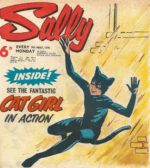 ‘Cat Girl’ was basically a junior edition of Miss Fury. Cathy Carter stumbles across a panther-skin suit gifted to her bumbling private detective father by a narratively convenient former client, an African witch-doctor. Obviously, she tries it on, and obviously it gives her feline attributes, including enhanced senses, balance, dexterity, speed and agility. Using her powers to help her father’s faltering career, Cathy’s adventures lasted Sally’s entire run and onward into Tammy. A large part of the strip’s appeal was the artwork of Giorgio Giorgetti, who gave Cathy and her cohorts an endearingly goofy aspect without making them ridiculous or unsympathetic.
‘Cat Girl’ was basically a junior edition of Miss Fury. Cathy Carter stumbles across a panther-skin suit gifted to her bumbling private detective father by a narratively convenient former client, an African witch-doctor. Obviously, she tries it on, and obviously it gives her feline attributes, including enhanced senses, balance, dexterity, speed and agility. Using her powers to help her father’s faltering career, Cathy’s adventures lasted Sally’s entire run and onward into Tammy. A large part of the strip’s appeal was the artwork of Giorgio Giorgetti, who gave Cathy and her cohorts an endearingly goofy aspect without making them ridiculous or unsympathetic.
 ‘Tiny Tania In Space’ and ‘The Girl from Tomorrow’ both had superlative art, detailed but whimsical, by Rodrigo Rodrigue Comos. In ‘Tania’, an orphaned girl runs away from abusive foster-parents and is accosted by an alien scientist who takes her back to his planet Karna, having shrunk her to a few inches in height to demonstrate his new invention. On Karna, Alaric, young son of another scientist, helps her escape and enlarge again – but residual effects of the shrink-ray hit Tania at unpredictable intervals during her ongoing adventures, alternating between super-power and handicap.
‘Tiny Tania In Space’ and ‘The Girl from Tomorrow’ both had superlative art, detailed but whimsical, by Rodrigo Rodrigue Comos. In ‘Tania’, an orphaned girl runs away from abusive foster-parents and is accosted by an alien scientist who takes her back to his planet Karna, having shrunk her to a few inches in height to demonstrate his new invention. On Karna, Alaric, young son of another scientist, helps her escape and enlarge again – but residual effects of the shrink-ray hit Tania at unpredictable intervals during her ongoing adventures, alternating between super-power and handicap.
‘The Girl From Tomorrow’ (no relation to the 1990s TV show) was Atlanta, a 23rd century maiden possessed of mind-over-matter powers common in her time (buck up, we’re only two centuries away…), who snoops in her uncle’s lab and gets zapped back to 1969. Her uncle, with a splendid indifference to Child Protection Services, decides to leave her in primitive times for a while to teach her a lesson, and, chumming up with falsely-accused pickpocket Alfie Dommett, the pair have madcap adventures in a charming series very much like a junior Bewitched or I Dream of Jeannie.
(no relation to the 1990s TV show) was Atlanta, a 23rd century maiden possessed of mind-over-matter powers common in her time (buck up, we’re only two centuries away…), who snoops in her uncle’s lab and gets zapped back to 1969. Her uncle, with a splendid indifference to Child Protection Services, decides to leave her in primitive times for a while to teach her a lesson, and, chumming up with falsely-accused pickpocket Alfie Dommett, the pair have madcap adventures in a charming series very much like a junior Bewitched or I Dream of Jeannie.
‘The Justice of Justine’ was Sally’s second super-heroine. Young Justine Jones aids a mysterious old man, accompanies him to a cave (Caution; not a 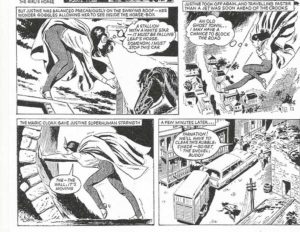 scenario usually resulting in super-powers – Just Say No, Kids!) and is rewarded with four magical artifacts: a cloak giving her flight, great strength, and courage, goggles which give her mystically enhanced vision, a bow & arrows which induce sleep and a mirror which serves as a supernatural pager, summoning her to her next mission. Alone among the main Sally series, Justine lacked a regular artist – her two-part adventures illustrated by many people, and although the roster included some distinguished names (John Burns, John Armstrong, Mike Noble), this unevenness, plus the inconsistency of her powers (flight and strength were constant, but the others came and went as the plot demanded, and one – talking to animals – just popped up without any explanation!), may have prevented the series gaining a greater following.
scenario usually resulting in super-powers – Just Say No, Kids!) and is rewarded with four magical artifacts: a cloak giving her flight, great strength, and courage, goggles which give her mystically enhanced vision, a bow & arrows which induce sleep and a mirror which serves as a supernatural pager, summoning her to her next mission. Alone among the main Sally series, Justine lacked a regular artist – her two-part adventures illustrated by many people, and although the roster included some distinguished names (John Burns, John Armstrong, Mike Noble), this unevenness, plus the inconsistency of her powers (flight and strength were constant, but the others came and went as the plot demanded, and one – talking to animals – just popped up without any explanation!), may have prevented the series gaining a greater following.
 An honourable mention must go to ‘Maisie’s Magic Eye’. While not sci-fi, and barely fantasy, the comedic adventures of Maisie Macrae proved to be the breakout hit of Sally, going on into Tammy and running for years. Primarily drawn by Robert MacGillivray, Maisie found a fragment of a glowing meteorite and made it into a brooch – as you would – which, when glowing, compelled others to do as Maisie commanded. This reboot of ‘Mimi the Mesmerist’ swiftly expanded its remit, however, as in later episodes the ‘Eye’ proved able to travel through time, transform objects or people, and generally rewrite reality – so of course Maisie used it to avoid extra PE, or take petty revenge on nagging prefects! Many stories stemmed from misunderstandings when Maisie expressed a wish without realising her literal-minded brooch was glowing. All avoidable if she’d learned to, oh, I don’t know, keep quiet and check before speaking!
An honourable mention must go to ‘Maisie’s Magic Eye’. While not sci-fi, and barely fantasy, the comedic adventures of Maisie Macrae proved to be the breakout hit of Sally, going on into Tammy and running for years. Primarily drawn by Robert MacGillivray, Maisie found a fragment of a glowing meteorite and made it into a brooch – as you would – which, when glowing, compelled others to do as Maisie commanded. This reboot of ‘Mimi the Mesmerist’ swiftly expanded its remit, however, as in later episodes the ‘Eye’ proved able to travel through time, transform objects or people, and generally rewrite reality – so of course Maisie used it to avoid extra PE, or take petty revenge on nagging prefects! Many stories stemmed from misunderstandings when Maisie expressed a wish without realising her literal-minded brooch was glowing. All avoidable if she’d learned to, oh, I don’t know, keep quiet and check before speaking!
It was a strong and engaging line up, and a genuine attempt to do something different… but alas, the experiment was short-lived.
With the issue dated 17th January 1970, ‘Justice of Justine’, ‘Tiny Tania In Space’ and ‘The Girl from Tomorrow’ were all axed, bringing the sf-centric iteration of Sally to a close. They were replaced by ‘Schoolgirl Princess’ (later ‘Sara’s Kingdom’, as our heroine ascended to the throne), ‘The Silent Shadows’ (another band of plucky schoolgirls thwarting the Reich in WWII – it’s a wonder the Nazis ever got anything done!) and ‘The Ghost Hunters’ (a US/UK schoolgirl duo investigating spooky doings). All quality strips, but all, it has to be said, safe bets, taste-alike versions of what had been done many times before. The editors, after just under six months, had clearly realized that the audience just wasn’t out there, and fell back on business as usual.
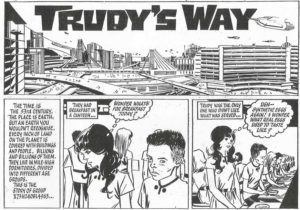 There was one more attempt at SF, commencing 19th September 1970; ‘Trudy’s Way’ featured an idealistic and imaginative girl in the desperate overcrowded Earth of the 53rd Century. Selected for a colonial expedition, she encourages her shipmates to overcome their fears and embrace a less regimented, more natural lifestyle. An interesting concept, swiftly ended after nine episodes, clearly not clicking with readers.
There was one more attempt at SF, commencing 19th September 1970; ‘Trudy’s Way’ featured an idealistic and imaginative girl in the desperate overcrowded Earth of the 53rd Century. Selected for a colonial expedition, she encourages her shipmates to overcome their fears and embrace a less regimented, more natural lifestyle. An interesting concept, swiftly ended after nine episodes, clearly not clicking with readers.
Sally itself went on until the 27th March 1971, as a well-done but unexceptional weekly. Its circulation had been hampered by a ten-week printers’ strike meaning no new issues between late ’70 and early ’71, and it never really regained lost ground. It was absorbed into the upstart Tammy – back then, only months old – with ‘Cat Girl’, Maisie’ comedy one-pager ‘Lulu’ and ‘Sara’s Kingdom’ making the jump. All but Maisie were gone by the end of 1972.
Gone, but not quite forgotten. Cat Girl appeared in the 1989/1990 Phase III of Morrison and Yeowell’s ‘Zenith’ in 2000 AD, meeting an unfortunate end in an underground station, and both Justine and Maisie had cameo appearances in Leah Moore and John Reppion’s Albion in 2005. Justine and Maisie also returned in 2019’s Tammy & Jinty Special, in all-new stories – albeit not quite as we remember them!
 Not a huge success during its initial run, Sally – especially the issues up to 17th January 1970 – is now hotly sought-after by back-issue collectors. At a short achievable run (83 issues, 1 Summer Special, 6 Annuals and two spin-offs (a Cookbook and a Book of Pets)), it has high collector appeal, and it is hoped that, like its sisters Misty and Jinty, Sally too, will be the subject of reprint re-releases, to delight and (sometimes bewilder) a new generation of readers.
Not a huge success during its initial run, Sally – especially the issues up to 17th January 1970 – is now hotly sought-after by back-issue collectors. At a short achievable run (83 issues, 1 Summer Special, 6 Annuals and two spin-offs (a Cookbook and a Book of Pets)), it has high collector appeal, and it is hoped that, like its sisters Misty and Jinty, Sally too, will be the subject of reprint re-releases, to delight and (sometimes bewilder) a new generation of readers.
Will Morgan, April 2020
Back to Top
The Persons From U.N.C.L.E.
It was the 1960s. Free love, psychedelia, counter culture, drugs, music and spies; spies were everywhere – you couldn’t walk round the block without tripping over hordes of them. Although James Bond started in books in 1953, it wasn’t until the 1960s, with Sean Connery as the silver screen Bond, that the spy craze really took off. Suddenly we were inundated; secret agents were anything but secret.
Our Man Flint, Get Smart, Danger Man, I Spy, The Man From B.U.N.G.L.E. (In Smash), the Girl From D.O.R.S.E.T, (in Judy), the Girls From N.O.O.D.L.E.S. (in Diana), Nick Fury, Agent of S.H.I.E.L.D., T.H.U.N.D.E.R. Agents – the list is seemingly E.N.D.L.E.S.S.! But my favourite (excluding the wonderful Avengers) was the Man From U.N.C.L.E.
 Back in the 1960s, we didn’t have streaming, DVDs or even videos, so had to rely on unpredictable repeats to see an episode of our favourite shows more than once. Small wonder then that TV such as the Man from UNCLE (we’re all friends here, so let’s drop the dots, eh?) successfully spun off into other media. There were Man From UNCLE films, comics, magazines, annuals, merchandise (I’m sure I must have had an UNCLE gun, and I can certainly remember sending off to join UNCLE and getting a membership card) and, most especially as far as I was concerned, a memorable series of novels. There were 23 in all; 16 published in the UK by Souvenir Press/Four Square, and a further seven (in addition) in the US only by Ace Books. The UK also had four Girl From UNCLE novels, three of which were not published in the US, although Ace published a fifth that wasn’t published in the UK.
Back in the 1960s, we didn’t have streaming, DVDs or even videos, so had to rely on unpredictable repeats to see an episode of our favourite shows more than once. Small wonder then that TV such as the Man from UNCLE (we’re all friends here, so let’s drop the dots, eh?) successfully spun off into other media. There were Man From UNCLE films, comics, magazines, annuals, merchandise (I’m sure I must have had an UNCLE gun, and I can certainly remember sending off to join UNCLE and getting a membership card) and, most especially as far as I was concerned, a memorable series of novels. There were 23 in all; 16 published in the UK by Souvenir Press/Four Square, and a further seven (in addition) in the US only by Ace Books. The UK also had four Girl From UNCLE novels, three of which were not published in the US, although Ace published a fifth that wasn’t published in the UK.
These fondly remembered volumes provided a resource to dip into when Robert Vaughn and David McCallum weren’t on our screens, and although they’re hardly great works of literature, they provided good escapist entertainment and have stayed with me for over fifty years; I re-read them all relatively recently. They had evocative titles in the same format at the TV series (The Radioactive Camel Affair, The Stone-Cold-Dead-In-The-Market Affair and the splendid Unfair Fare Affair) and were written by a large number of different authors.
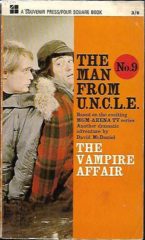 It’s generally recognised that David McDaniel is the best of the many to turn their hand to a Man From UNCLE novel; he wrote six of the 23. My favourite is the Vampire Affair (UK #9), where Napoleon and Illya are in the Transylvanian Alps on an adventure with an East European nobleman who just might – or might not – be a vampire. Told with a nice mix of action, horror and humour, our heroes are portrayed spot-on and the writing is clever and entertaining. So too with McDaniel’s Dagger Affair (UK #6), where there is an uneasy alliance with Thrush in the second best book in the series. All of McDaniel’s outings are good, although the Rainbow Affair (US #13) deserves a special mention for the unnamed cameos by Sherlock Holmes, Steed and Mrs. Peel, Simon Templar, Chief Inspector Teal, Father Brown, Fu Manchu, Miss Marple, Neddy Seagoon and even James Bond.
It’s generally recognised that David McDaniel is the best of the many to turn their hand to a Man From UNCLE novel; he wrote six of the 23. My favourite is the Vampire Affair (UK #9), where Napoleon and Illya are in the Transylvanian Alps on an adventure with an East European nobleman who just might – or might not – be a vampire. Told with a nice mix of action, horror and humour, our heroes are portrayed spot-on and the writing is clever and entertaining. So too with McDaniel’s Dagger Affair (UK #6), where there is an uneasy alliance with Thrush in the second best book in the series. All of McDaniel’s outings are good, although the Rainbow Affair (US #13) deserves a special mention for the unnamed cameos by Sherlock Holmes, Steed and Mrs. Peel, Simon Templar, Chief Inspector Teal, Father Brown, Fu Manchu, Miss Marple, Neddy Seagoon and even James Bond.
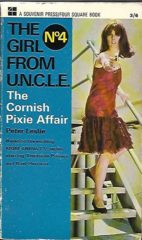 Peter Leslie was perhaps the next in line in terms of quality; he had a reasonably accurate handle on the characterisation of the cast and a strong sense of locale in the agents’ globe-trotting adventures, whether that was in the South Of France (the Finger In The Sky Affair UK #5), The Sudan (The Radioactive Camel Affair UK #7, introducing the well realised character of information guru Habib Tufik, who would appear in later novels) or Brazil (The Diving Dames Affair UK #10). Leslie could be just a tad dull occasionally, but could usually be relied on for a solid, entertaining job. His Cornish Pixie Affair (Girl from UNCLE UK #4) is easily the best of April Dancer’s and Mark Slate’s outings in this format.
Peter Leslie was perhaps the next in line in terms of quality; he had a reasonably accurate handle on the characterisation of the cast and a strong sense of locale in the agents’ globe-trotting adventures, whether that was in the South Of France (the Finger In The Sky Affair UK #5), The Sudan (The Radioactive Camel Affair UK #7, introducing the well realised character of information guru Habib Tufik, who would appear in later novels) or Brazil (The Diving Dames Affair UK #10). Leslie could be just a tad dull occasionally, but could usually be relied on for a solid, entertaining job. His Cornish Pixie Affair (Girl from UNCLE UK #4) is easily the best of April Dancer’s and Mark Slate’s outings in this format.
After them, the series is a bit more patchy. Michael Avallone wrote the first in the series (The Man From UNCLE UK #1), and although a competent spy adventure, he didn’t really capture the characters or the feel of the series (the same can be said of his two Girl From UNCLE stories). So too for Harry Whittington’s Doomsday Affair (UK #2); once again a competent if somewhat violent plot more reminiscent of a James Bond novel than an UNCLE one. John Oram contributed two early novels (The Copenhagen Affair UK #3 and the Stone Cold-Dead-In-The Market-Affair UK #4) and he was very strong on sense of location (Denmark and Wales respectively); the plots and writing were good, if again they seemed not to feature the Napoleon and Illya we knew from TV. I’m pleased to say that my least favourite book in the series (Joel Bernard’s Thinking Machine Affair UK #11) was not as badly written as I remembered it to be upon my re-read.
 There’s good stuff among the rest. I particularly enjoyed John T. Phillifent’s Mad Scientist Affair (UK #8), with its gothic Irish castle setting and memorable beer truck chase. J. Hunter Holly’s Assassination Affair (US #10), although well written, is really two novellas unconvincingly linked, and Thomas Stratton contributes two novels with almost sci-fi plots (invisibility and mind-warping). The Cross OF Gold Affair by Frederic Davies (US #14) features a memorable villain called Porpoise, a Coney Island setting and our heroes’ amusing encounters with hippies. These last few are among the books published in the US only, and thus I didn’t get to read them as a kid. Having come to them as an adult, they have a different resonance to me, but still with much to appreciate.
There’s good stuff among the rest. I particularly enjoyed John T. Phillifent’s Mad Scientist Affair (UK #8), with its gothic Irish castle setting and memorable beer truck chase. J. Hunter Holly’s Assassination Affair (US #10), although well written, is really two novellas unconvincingly linked, and Thomas Stratton contributes two novels with almost sci-fi plots (invisibility and mind-warping). The Cross OF Gold Affair by Frederic Davies (US #14) features a memorable villain called Porpoise, a Coney Island setting and our heroes’ amusing encounters with hippies. These last few are among the books published in the US only, and thus I didn’t get to read them as a kid. Having come to them as an adult, they have a different resonance to me, but still with much to appreciate.
Finally, a brief word on the Girl From Uncle novels. With the honourable exception of the Cornish Pixie affair referenced above, none of the authors here really captured the times, despite Simon Latter’s portrayal of Carnaby Street and swinging London in the Global Globules Affair (Girl From UNCLE UK #1); April and Mark were reasonably portrayed in both Latter’s efforts, but the books did seem to lack an exciting dynamic.
Having said all that, the books are all quick to read, feature outlandish schemes by Thrush and other interests to rule or undermine the world and give Napoleon Solo, Illya Kuryakin, April Dancer, Mark Slate and their boss Alexander Waverly a chance to save us all, time after time. The spy genre was never the same again as it had been in the 1960s, and we should all rejoice in the adventure, the characters, the humour and the atmosphere of the time evoked.
Rob Rudderham, April 2020
Back to Top
Looking for Love in all the wrong places – the strange story of Fishboy, Denizen of the Deep
 Buster weekly, launched in 1960, front-loaded its humour strips and appeared to be a purely ‘funny’ book, but for its first fifteen years it featured a high ratio of adventure strips behind its comedy façade. In the issue dated 20th January 1968, the longest-running and most successful adventure series to that point debuted – ‘Fishboy’.
Buster weekly, launched in 1960, front-loaded its humour strips and appeared to be a purely ‘funny’ book, but for its first fifteen years it featured a high ratio of adventure strips behind its comedy façade. In the issue dated 20th January 1968, the longest-running and most successful adventure series to that point debuted – ‘Fishboy’.
Well, technically, it was the first issue of Buster and Giggle. In the ‘hatch, match and despatch’ practice of British weeklies (where with a ‘great news, chums!’ strapline, the readers would be informed one failing comic would be amalgamated with another to boost readership), the short-lived (and frankly a bit rubbish) Giggle had been shoehorned into Buster. But since Giggle’s line-up, mainly money saving European reprints, had so little to bring to the table, a brand new strip was launched in the first ‘amalgam’ issue.
 ‘Fishboy’ was a classic example of the ‘feral child’ trope (abandoned in exotic setting, raised by non-humans) beloved of fictioneers since Mowgli and Tarzan. Fishboy had been mislaid by his travelling geologist parents in the tropical islands of New Guinea. You know how it is – you pick up a lot of interesting stuff on the trip, and something’s got to be left behind to avoid excess baggage fees!
‘Fishboy’ was a classic example of the ‘feral child’ trope (abandoned in exotic setting, raised by non-humans) beloved of fictioneers since Mowgli and Tarzan. Fishboy had been mislaid by his travelling geologist parents in the tropical islands of New Guinea. You know how it is – you pick up a lot of interesting stuff on the trip, and something’s got to be left behind to avoid excess baggage fees!
Foraging in the ocean for food, the infant adapted to be able to swim superhumanly fast, breathe underwater, withstand undersea pressures, and communicate with all sea life because Of Course Biology Works Like That!
 Wearing only the tiniest seaweed swimsuit – knitted by kindly old Ma Dolphin, for all we know – Fishboy was inspired by a chance find of a photograph to seek his ‘beloved parents’ – who, to be fair, had assumed him lost at sea, explaining why they never bothered searching. Thus commenced eight years of a barely-clad, lithe, athletic blond teenage boy, swimming all over the globe, wandering hopefully up to total strangers, and asking them: “Are you my Daddy?” Ahem.
Wearing only the tiniest seaweed swimsuit – knitted by kindly old Ma Dolphin, for all we know – Fishboy was inspired by a chance find of a photograph to seek his ‘beloved parents’ – who, to be fair, had assumed him lost at sea, explaining why they never bothered searching. Thus commenced eight years of a barely-clad, lithe, athletic blond teenage boy, swimming all over the globe, wandering hopefully up to total strangers, and asking them: “Are you my Daddy?” Ahem.
Fishboy was by writer Scott Goodall and artist John Stokes. Goodall was to revisit the ‘feral child’ theme at least twice more, with ‘Kid Chameleon’ in Cor!! (desert waif, raised by lizards, artist Joe Colquhoun) and ‘Kangaroo Kid’ (Australian outback, marsupials, John Stokes again), but Fishboy outlived both, partly because his super-swimming skills enabled all sorts of exotic vistas to be evoked with a mere ‘Searching for his parents, our hero swims to the coast of Wherever’, whereas his landbound brethren were confined to a small set of locations.
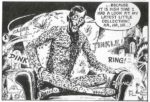 As the strip progressed, Goodall’s imagination placed our hero against ever more bizarre antagonists. Although Fishboy was super-human, he wasn’t specifically a super-hero – his quest was to find his parents, not to fight crime – yet he nevertheless got embroiled in situations where people were being abused or exploited, and his highly-developed sense of justice, coupled with an almost childish naiveté, caused him to intercede. At first his opponents were oddly-named eccentrics, but eventually developed into virtual super-villains. Black-Hat O’Brien; Heinrich the Strong and Tree-Stump; The Collector; Agokk the Mask; Rum-Jungle Jones; Boomerang Bailey; Johnny Mountain; Karag the Crab; Houndstooth Hangerman; the Black Leopards – it was a collection of freaks worthy of Dick Tracy or Batman’s Gotham!
As the strip progressed, Goodall’s imagination placed our hero against ever more bizarre antagonists. Although Fishboy was super-human, he wasn’t specifically a super-hero – his quest was to find his parents, not to fight crime – yet he nevertheless got embroiled in situations where people were being abused or exploited, and his highly-developed sense of justice, coupled with an almost childish naiveté, caused him to intercede. At first his opponents were oddly-named eccentrics, but eventually developed into virtual super-villains. Black-Hat O’Brien; Heinrich the Strong and Tree-Stump; The Collector; Agokk the Mask; Rum-Jungle Jones; Boomerang Bailey; Johnny Mountain; Karag the Crab; Houndstooth Hangerman; the Black Leopards – it was a collection of freaks worthy of Dick Tracy or Batman’s Gotham!
Not to suggest, though, that villainy was the sole mainspring of Fishboy’s adventures. In between battles with such antagonists, he helped all manner of folk above the seas and below, many of his stories having a distinct (and at the time definitely un-trendy) ecological subtext.
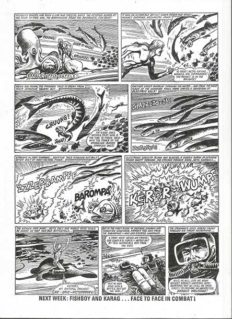 John Stoke’s artwork was the series’ greatest asset. Meticulous, polished and painstakingly researched, it captures both the underwater and landlocked milieu with an attention to detail and atmosphere which is all the more remarkable considering that Stokes was generating this quality at the rate of two pages per week for a solid eight years, with other side gigs!
John Stoke’s artwork was the series’ greatest asset. Meticulous, polished and painstakingly researched, it captures both the underwater and landlocked milieu with an attention to detail and atmosphere which is all the more remarkable considering that Stokes was generating this quality at the rate of two pages per week for a solid eight years, with other side gigs!
Then, there’s… well, the other matter. I mentioned the ‘vealcake jailbait’ aspect of Fishboy earlier, somewhat jokingly, but I’m not the only one to notice. Other comics critics have pointed out that in the Fishboy series, we have a gym-fit, nearly-naked blond lad of sixteen or so who gets tied up a lot.
I mean, a LOT.
Over the course of the series, he was bound with ropes and chains so often that the creators utilised ever more imaginative forms of restraint – lassoed, tied up by a ‘living rope’ of eels, hogtied inside a large tyre, netted, spread-eagled between wild horses, flash-frozen, ensnared in what appears to be an electrified chastity belt… not to mentioned at least twice being drugged into unconsciousness so he can be ‘examined’ by excited ‘scientists’. As Rupert Giles famously observed: “Sometimes the subtext becomes the text.”
 You may accuse me of having a nasty mind – guilty as charged – but it’s something that’s come up in other people’s reviews of the strip. One can’t help but wonder if there was some alternative demographic diligently ticking those ‘My Favourite Story’ coupons every week to help keep Fishboy afloat for so many years!
You may accuse me of having a nasty mind – guilty as charged – but it’s something that’s come up in other people’s reviews of the strip. One can’t help but wonder if there was some alternative demographic diligently ticking those ‘My Favourite Story’ coupons every week to help keep Fishboy afloat for so many years!
Nevertheless, the strip had considerable merits in its own right. Fast-paced adventure, a fearless if naïve hero, a dazzling variety of locations, and sumptuous art all combined to give the strip a longevity unmatched in Buster until the crown was snatched by the late-coming ‘Leopard from Lime Street’.
But the end eventually came for Fishboy. On the trail of another sighting of his elusive parents – a trope played many times in the series before, only to turn out to be mistaken identity, a deliberate mislead, or a contrived failure to cross paths – our hero was finally reunited with his parents in Buster dated 6th December 1975.
That semed to sink Fishboy without trace. But others remembered the series, and after decades, he was acknowledged in two other series.
In 1989 and 1990, Phase III of Grant Morrison and Steve Yeowell’s ‘Zenith’ from 2000 AD, featured Fishboy and myriad other characters from British comics (either the real deal or slightly altered archetypes depending on copyright) battling an invasion by pan-dimensional beings. It didn’t go well for the cannon fodder, and while Fishboy’s fate wasn’t shown on-panel, we’re left to infer that he got a tube train dropped on him.
Still, at least that version looked human, seaweed speedo and all, whereas the one-panel cameo by Fishboy in 2005’s Albion by Leah Moore and John Reppion showed him as a mutated specimen in a jar, with more exaggerated fishlike features and a grotesque non-human appearance.
 After more than a thousand pages – counting a handful of extra stories drawn for Annuals and Specials – of amphibious action, adventure and ambivalent sexuality, Fishboy must surely be due for a reprint revival by the Rebellion Publishing folks? Sarcastic remarks aside – and the series does rather invite them – the quality of the work is too good to be left to languish in a backwater.
After more than a thousand pages – counting a handful of extra stories drawn for Annuals and Specials – of amphibious action, adventure and ambivalent sexuality, Fishboy must surely be due for a reprint revival by the Rebellion Publishing folks? Sarcastic remarks aside – and the series does rather invite them – the quality of the work is too good to be left to languish in a backwater.
Will Morgan, April 2020
Back to Top
Fantastic Fours
The scientist/leader. His best friend (who’s big and strong). His girlfriend. Her kid brother. Sound familiar? Yes, of course, that’s the format of the team in Rip Hunter, Time Master… Before this tried and tested line-up was borrowed by Stan & Jack to usher in the Marvel Age of Comics with Fantastic Four #1 (November 1961), DC had several attempts with very similarly related groups of characters.
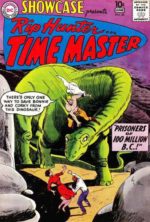 Rip Hunter, Time Master debuted in DC’s try-out title Showcase in May 1959, four and a half years before a certain time-travelling Time Lord (there are similarities in that Rip’s Time Sphere travelled in time and occasionally space, combining historical settings with science-fiction themes from time to time). Rip was a scientist who invented said Time Sphere and persuaded his friends to accompany him on various adventures in which they encountered Hitler, George Washington and Cleopatra, among many others; aliens and magical adversaries were also not uncommon. Rip’s companions comprised Jeff Smith, his strong best friend, Bonnie Baxter, his girlfriend, and Corky Baxter, her kid brother. They first appeared dressed in ‘civvies’ but later adopted a team costume. Created by writer Jack Miller and artist Ruben Moreira, the concept was popular enough to get four try-outs in Showcase before being promoted to its own series which lasted 29 issues. Time travel stories are always engaging, with a different setting each issue, and although the writing and art was sometimes patchy, there is imagination, adventure and humour within the pages of this fine series and outstanding issues drawn by Mike Sekowsky, Joe Kubert and Alex Toth.
Rip Hunter, Time Master debuted in DC’s try-out title Showcase in May 1959, four and a half years before a certain time-travelling Time Lord (there are similarities in that Rip’s Time Sphere travelled in time and occasionally space, combining historical settings with science-fiction themes from time to time). Rip was a scientist who invented said Time Sphere and persuaded his friends to accompany him on various adventures in which they encountered Hitler, George Washington and Cleopatra, among many others; aliens and magical adversaries were also not uncommon. Rip’s companions comprised Jeff Smith, his strong best friend, Bonnie Baxter, his girlfriend, and Corky Baxter, her kid brother. They first appeared dressed in ‘civvies’ but later adopted a team costume. Created by writer Jack Miller and artist Ruben Moreira, the concept was popular enough to get four try-outs in Showcase before being promoted to its own series which lasted 29 issues. Time travel stories are always engaging, with a different setting each issue, and although the writing and art was sometimes patchy, there is imagination, adventure and humour within the pages of this fine series and outstanding issues drawn by Mike Sekowsky, Joe Kubert and Alex Toth.
Less than a year later, in August 1960, two more teams of four adventurers debuted in Showcase and DC’s other try-out title The Brave & The Bold.
 Sea Devils (no connection to the Dr Who story of the same name), beginning in Showcase #27 comprised leader Dane Dorrance, his big strong best friend Biff Bailey, his girlfriend Judy Walton and her kid brother Nicky. These four were engaged in undersea adventures at the hands of Robert Kanigher (writer) and Russ Heath (artist). The same dynamic existed between the team as with Rip Hunter & co. The Sea Devils had undersea adventures for three issues of Showcase and 35 of their own series. I think they may have stumbled across more lost civilizations than Tarzan did in Africa (and that’s going some!), and a monster lurked within every coral reef. Their early adventures were often mind-warpingly wild as was the case with a lot of ‘Barking’ Bob Kanigher’s output, and the art by Russ Heath was superlative (you could really believe these adventures were happening underwater). Later, after the departures of the creators, subsequent hands provided more ordinary fare, though competently done for the most part.
Sea Devils (no connection to the Dr Who story of the same name), beginning in Showcase #27 comprised leader Dane Dorrance, his big strong best friend Biff Bailey, his girlfriend Judy Walton and her kid brother Nicky. These four were engaged in undersea adventures at the hands of Robert Kanigher (writer) and Russ Heath (artist). The same dynamic existed between the team as with Rip Hunter & co. The Sea Devils had undersea adventures for three issues of Showcase and 35 of their own series. I think they may have stumbled across more lost civilizations than Tarzan did in Africa (and that’s going some!), and a monster lurked within every coral reef. Their early adventures were often mind-warpingly wild as was the case with a lot of ‘Barking’ Bob Kanigher’s output, and the art by Russ Heath was superlative (you could really believe these adventures were happening underwater). Later, after the departures of the creators, subsequent hands provided more ordinary fare, though competently done for the most part.
 So, the Sea Devils had under the oceans covered, whilst over at the Brave & the Bold, Cave Carson and his chums were doing the same thing under the Earth. Cave was the least successful of these classic foursomes; despite no less than five try-out issues in Brave & Bold (commencing with #31) and a further three in Showcase, Cave never graduated to his own series. Created by Ed Herron (writer) and Bruno Premiani (artist), the dynamic was slightly different here. Cave was the leader, with his big strong best friend Bulldozer Smith and his girlfriend Christie Madison, and there it stopped initially (unless you count Bulldozer’s pet lemur Lena as the fourth member, but that would just be silly). A few issues later they got their fourth member: Johnny Blake, but despite being a young hothead, he was not Christie’s brother – rather he was Cave’s rival for her affections. Cave and co. descended into the Earth in their Mighty Mole, to discover it was just as populated as under the ocean with lost civilizations (had the series gone on long enough, they would surely have encountered Dr Who’s Silurians). Their adventures were fairly standard offerings, and perhaps it’s not hard to see why this series was the least successful under scrutiny here, although special mention should be made of one superb issue (Brave & Bold #40), illustrated by Joe Kubert at the height of his powers.
So, the Sea Devils had under the oceans covered, whilst over at the Brave & the Bold, Cave Carson and his chums were doing the same thing under the Earth. Cave was the least successful of these classic foursomes; despite no less than five try-out issues in Brave & Bold (commencing with #31) and a further three in Showcase, Cave never graduated to his own series. Created by Ed Herron (writer) and Bruno Premiani (artist), the dynamic was slightly different here. Cave was the leader, with his big strong best friend Bulldozer Smith and his girlfriend Christie Madison, and there it stopped initially (unless you count Bulldozer’s pet lemur Lena as the fourth member, but that would just be silly). A few issues later they got their fourth member: Johnny Blake, but despite being a young hothead, he was not Christie’s brother – rather he was Cave’s rival for her affections. Cave and co. descended into the Earth in their Mighty Mole, to discover it was just as populated as under the ocean with lost civilizations (had the series gone on long enough, they would surely have encountered Dr Who’s Silurians). Their adventures were fairly standard offerings, and perhaps it’s not hard to see why this series was the least successful under scrutiny here, although special mention should be made of one superb issue (Brave & Bold #40), illustrated by Joe Kubert at the height of his powers.
 A year and a bit later saw Fantastic Four #1 hit the stands. Stan Lee had been charged with coming up with a title to rival the success of DC’s Justice League of America, but he didn’t follow the format of DC’s flagship title by bringing together all their most famous established characters into one team. He couldn’t do that at that time of course because Marvel didn’t have any established characters, so instead he copied the dynamic and formula of the DC teams we’ve been discussing. Like Rip Hunter and his chums, they first appeared in normal clothes before getting costumes in a later issue, and Sue Storm of course had her hothead kid brother, but the Sub-Mariner came along in issue #4 to fulfil the other half of the Johnny Blake character. (Stan Lee and Jack Kirby would of course go on to use the JLA format for the Avengers a couple of years later). Unlike their format predecessors, the Fantastic Four had super powers and went on to fight super-villains etc to become the most famous example of this four hero line-up in comics’ history. But Rip and Cave and the Sea Devils got there first.
A year and a bit later saw Fantastic Four #1 hit the stands. Stan Lee had been charged with coming up with a title to rival the success of DC’s Justice League of America, but he didn’t follow the format of DC’s flagship title by bringing together all their most famous established characters into one team. He couldn’t do that at that time of course because Marvel didn’t have any established characters, so instead he copied the dynamic and formula of the DC teams we’ve been discussing. Like Rip Hunter and his chums, they first appeared in normal clothes before getting costumes in a later issue, and Sue Storm of course had her hothead kid brother, but the Sub-Mariner came along in issue #4 to fulfil the other half of the Johnny Blake character. (Stan Lee and Jack Kirby would of course go on to use the JLA format for the Avengers a couple of years later). Unlike their format predecessors, the Fantastic Four had super powers and went on to fight super-villains etc to become the most famous example of this four hero line-up in comics’ history. But Rip and Cave and the Sea Devils got there first.
There were other foursomes from DC where the format was a bit different (Challengers Of The Unknown, the Suicide Squad, even the Doom Patrol) and mention might just be made of another foursome, the Fab Four from Dell, much later in 1967 (in a very silly series called the Super-Heroes), but there was no congruency there, any more than there was with the real Fab Four, which leads me to the Monkees (also a comic version from Dell), and then on to DC’s Maniaks, which almost followed our pattern, but then, like some four colour Ouroboros, I’m eating my own tail.
Rob Rudderham, April 2020
Back to Top
The Short but Brilliant Life of the Inferior Five
“You wouldn’t hit a woman with a BABY, would you?”
“No! I’d hit her with a GROWN MAN!”
Despite a short shelf-life – subsequent revivals and ‘updatings’ ranging from mediocre to disastrous – the original series of DC’s Inferior Five remains fondly remembered by a certain generation of comics readers, despite their throwaway origins.
 In early 1966 E. Nelson Bridwell, one of the first fans-turned pro in comics, was asked to produce a parody of Marvel’s Fantastic Four for an issue of Showcase. Rather than produce a simple satire with look-alike versions of the FF, ENB expanded the concept, adding a fifth member and adding the genius touch making them what are now called ‘legacy’ heroes – the grown offspring of the Freedom Brigade, legendary (in the sense that they were entirely made up for the series) super-heroes of the Golden Age.
In early 1966 E. Nelson Bridwell, one of the first fans-turned pro in comics, was asked to produce a parody of Marvel’s Fantastic Four for an issue of Showcase. Rather than produce a simple satire with look-alike versions of the FF, ENB expanded the concept, adding a fifth member and adding the genius touch making them what are now called ‘legacy’ heroes – the grown offspring of the Freedom Brigade, legendary (in the sense that they were entirely made up for the series) super-heroes of the Golden Age.
Our ‘heroes’, for want of a better word, were:
Merryman, son of Lady Liberty and the Patriot, saddled with a heroic tradition on both sides of the family dating back at least a century. Although highly intelligent and intensively trained in unarmed combat, Myron Victor’s Walter-the-Softy physique made all his training ineffective.
Dumb Bunny, daughter of Princess Power; although possessed of her mother’s incredible strength, Athena Tremor utterly lacked the wisdom of her namesake goddess.
The Blimp, son of Captain Swift, inheritor of his father’s power of flight, but no super-speedster, easily outpaced by enemies at a slow walk.
Awkwardman, amphibious son of Mr. Might and the Mermaid; his incredible strength and ability to breath under water were bequests from his parents, but – perhaps because of his hybrid nature – his calamitous clumsiness was all his own.
And the White Feather, son of the Bowman, whose archery skills were every bit as great as his father’s, but whose shaking hands, thanks to his incredible cowardice, negated his marksmanship.
Though none of them would have entered the super-heroic profession by choice, they weren’t given any; their parents’ expectations trapped them in a world for which they were ill-equipped, and they caved in to parental pressure rather than forge their own paths.
Their first outing was against Doctor Gregory Gruesome, a mad scientist only slightly more exaggerated than Luthor & company, whose delighted exclamation: “A chance to shoot a woman – in the back! What villain could resist?” set the tone for the series, a charming combination of slapstick, whimsy and a loving excoriation of super-hero clichés.
 With the artistic aid of Joe Orlando (in Showcase #62 & #63) and Mike Sekowsky (Showcase #65, Inferior Five #1-6), E. Nelson Bridwell demonstrated his encyclopaedic knowledge of the entire heroic mythos. In a handful of issues, ENB gleefully skewered the Avengers, the X-Men, the Fantastic Four (he got there eventually…), Giant-Man and the Wasp, the Hulk, the THUNDER Agents, the Man from UNCLE, Tarzan of the Apes, the Green Hornet and Kato, the Scarlet Pimpernel and more. The high spot was issue #4, his take on Thor and the gods of Asgard, which despite its comedic nature proffered, as critic Kathleen Glancy observed: “More authentic Norse mythology in a single issue than the entire run of Lee and Kirby’s Thor.”
With the artistic aid of Joe Orlando (in Showcase #62 & #63) and Mike Sekowsky (Showcase #65, Inferior Five #1-6), E. Nelson Bridwell demonstrated his encyclopaedic knowledge of the entire heroic mythos. In a handful of issues, ENB gleefully skewered the Avengers, the X-Men, the Fantastic Four (he got there eventually…), Giant-Man and the Wasp, the Hulk, the THUNDER Agents, the Man from UNCLE, Tarzan of the Apes, the Green Hornet and Kato, the Scarlet Pimpernel and more. The high spot was issue #4, his take on Thor and the gods of Asgard, which despite its comedic nature proffered, as critic Kathleen Glancy observed: “More authentic Norse mythology in a single issue than the entire run of Lee and Kirby’s Thor.”
It all went a bit pear-shaped with issue #6. In what, in retrospect, was an attempt to ‘Marvel Bullpen’ the DC offices, the issue was a satirical look at the creators, alienating the readership at a stroke by cracking a plethora of in-jokes about people the reader knew little of and cared less. My ten-year old self was bitterly disappointed when not only the multitude of cover-featured guest-stars failed to appear inside, but the heroes themselves graced only a handful of panels, and decades later, my heart remains a seething ball of resentment towards #6!
 With #7, there was a definite change in tone. Win Mortimer took over the art – his amiable cartooniness suiting the light-hearted tone – but while the stories remained credited to Bridwell, either they were being ghost-written (as some critics, including Mark Evanier, aver) or he had been instructed to dumb it down, with more slapstick and throwaway gags, and no references to panelological or literary history. The parodies were still in play – Iron Pants, Cobweb Kid – but obvious and dismissive, with no-one’s heart seemingly in it. Other than #9, a delightful ‘Night at the Museum’ issue which was pure comedy rather than satire, the later issues of the Five were thin fare compared to previous stellar efforts.
With #7, there was a definite change in tone. Win Mortimer took over the art – his amiable cartooniness suiting the light-hearted tone – but while the stories remained credited to Bridwell, either they were being ghost-written (as some critics, including Mark Evanier, aver) or he had been instructed to dumb it down, with more slapstick and throwaway gags, and no references to panelological or literary history. The parodies were still in play – Iron Pants, Cobweb Kid – but obvious and dismissive, with no-one’s heart seemingly in it. Other than #9, a delightful ‘Night at the Museum’ issue which was pure comedy rather than satire, the later issues of the Five were thin fare compared to previous stellar efforts.
And with #10, the series was done. A two-issue reprint revival in the early 1970s was all we saw of the Five, apart from cameos in various crossover events, until the second series of Angel & the Ape in 1991. This revival of another ENB creation was helmed by Phil Foglio, famous for the cheerful and witty porno comic Xxxenophile. Fogio linked the two series by establishing Dumb Bunny and Angel O’Day as half-sisters, and with Bunny a supporting character in the series, the rest of the Five inevitably turned up, playing a major part in the conclusion. Foglio reputedly wanted to follow up with an Inferior Five mini, but A & A’s sales, alas, didn’t justify it.
The Five’s last hurrah, oddly enough, was unexpectedly in the morass of… (shudder) modern comics. In the final issue of the early 2000s Brave & Bold, #35. The Legion of Substitute Heroes, in an attempt to get some publicity, travel back to the past to pick up the Doom Patrol and save Earth from destruction. Owing to a series of unfortunate events, the Subs end up with the Inferior Five instead, and the Five’s eternal dumb luck, plus Dumb Bunny’s intellect (!) saves the day: “You have to be pretty smart to act as dumb as I do, you know!” Michael Straczynski and Jesus Saiz, to everyone’s astonishment, ‘got’ the Five. Who’d have thought?
There have been other appearances by the Inferior Five, but none worth dignifying with inclusion – either fleeting cameos, or reboots or retrofits, missing the point and the appeal of the team entirely.
But what made the Five distinctive? The quality of the creators, sure. The comedy, absolutely. But the keynote of the Five’s appeal was their paradoxical courage in the face of all obstacles. They, more than anyone else, were aware of their deficiencies, but they pulled on their big-boy pants and went out to fight the forces of evil anyway, despite the looming spectre of almost certain defeat. They pooled their meagre talents and achieved something greater than themselves. And the lack of self-awareness in the later issues, when the Five seemed to be ignorant of their own drawbacks, may be where the strip lost its heart, and consequently its uniqueness. But when the strip was at its peak, it remains unique, a parody with a soul.
Recommended Issues: Showcase (1956) #62, #63, #65, Inferior Five (1967) #1-5, #9, Angel & The Ape (1991) #1-4, Brave & Bold (2007) #35.
Will Morgan, April 2020
Back to Top
What’s In A Name? Why We’re Called ’30th Century Comics’
We have been asked on many occasions why we’re called ‘30th Century Comics’, particularly why such a futuristic name for a business that specialises in vintage comics and books?
 Of course, many comic fans will recognise that the 30th Century was the original setting for the DC series the Legion of Super-Heroes, the founding characters of which debuted in the Superboy story in Adventure Comics #247 (April 1958). The LSH was the favourite series of three out of the four of us who formed the business (and our fourth partner was a fan too!). When we got together to form a comic business in 1994, we therefore wanted a name that celebrated our heroes, particularly since three of us met through an APA (Amateur Press Alliance) devoted to the LSH. It was Will who suggested ‘30th Century Comics’ , and it seemed appropriate without being too obvious.
Of course, many comic fans will recognise that the 30th Century was the original setting for the DC series the Legion of Super-Heroes, the founding characters of which debuted in the Superboy story in Adventure Comics #247 (April 1958). The LSH was the favourite series of three out of the four of us who formed the business (and our fourth partner was a fan too!). When we got together to form a comic business in 1994, we therefore wanted a name that celebrated our heroes, particularly since three of us met through an APA (Amateur Press Alliance) devoted to the LSH. It was Will who suggested ‘30th Century Comics’ , and it seemed appropriate without being too obvious.
That was a long time ago (over 26 years now), and things move on. We survived a fire above our premises and bounced back from an ensuing closure of six weeks. Sadly, one of our founders died. We carried on, forging our business into very much the type of comic shop we’d like to visit, adding British comics and vintage books to our stock. A few years ago we dropped new imported American comics from our operation in order to concentrate on the vintage back issues we love. Today, we believe we are uniquely placed in the world, selling vintage comics (both American and British) and genre books in a bricks and mortar shop as well as a thriving mail order worldwide business. Currently, in 2020 of course, we have had to close our doors temporarily due to the coronavirus pandemic; but we’ll be back.
The Legion of Super-Heroes has moved on too, in a chequered career of highs and lows at DC Comics. But we’ve resisted rebranding as 31st Century Comics; the roots of what drew us together can be found in those wonderful Legion of Super-Heroes stories from the late 1950s and early 1960s (the best of which were scripted initially by science fiction alumnus Edmond Hamilton), when Legion teams were picked by a Planetary Chance Machine, when Light Lass exercised with a Cellular Trim-Ray and Invisible Kid put his foot on the gas pedal to accelerate the Legion spaceship. It’s that retro future vibe that typifies what we sell and what we stand for – welcome to the 30th Century, way back when.
Rob Rudderham, March 2020
Back to Top









